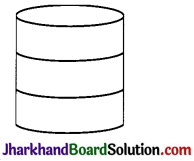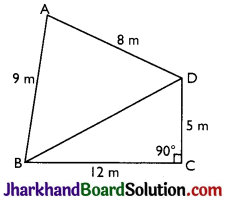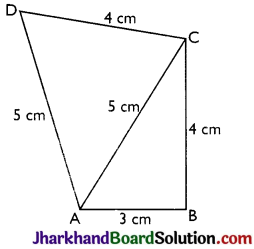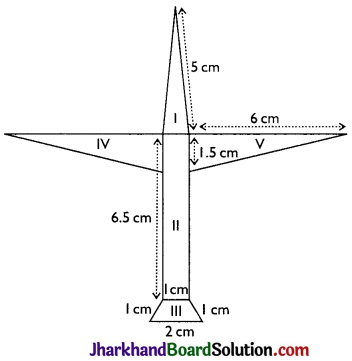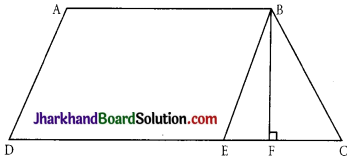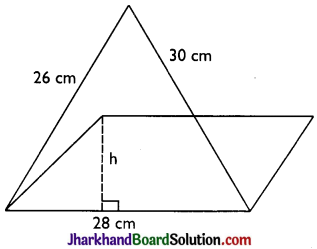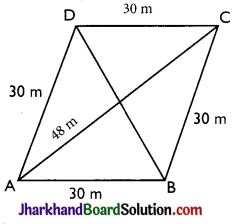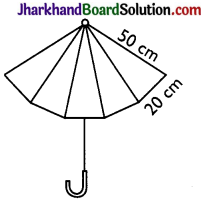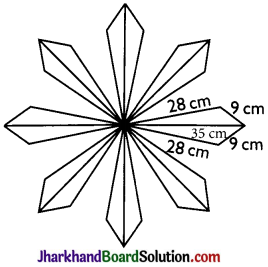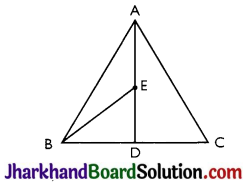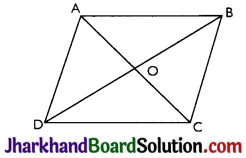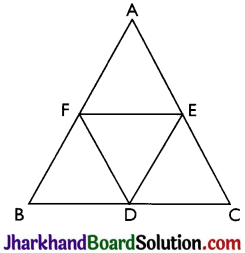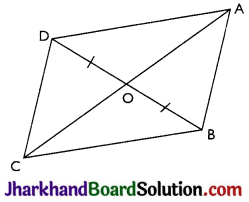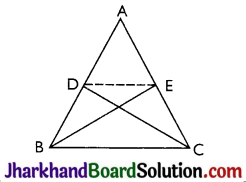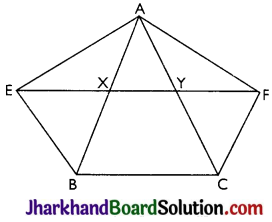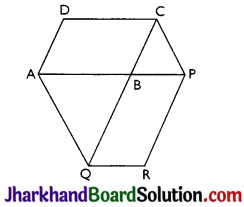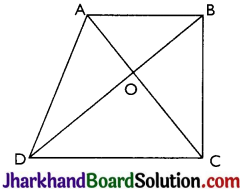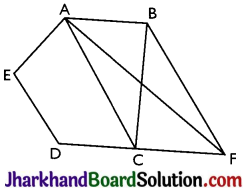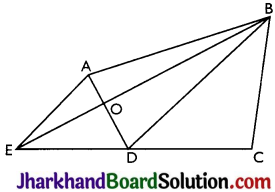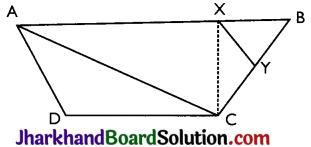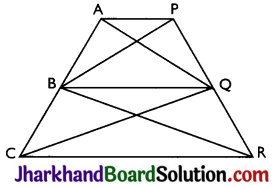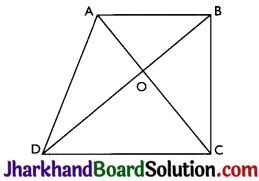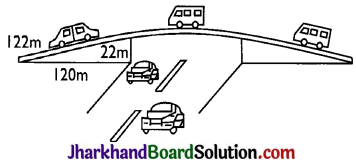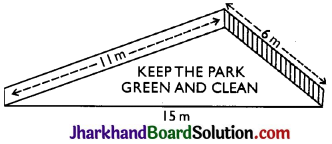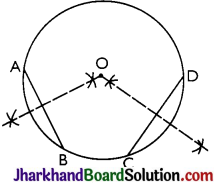Jharkhand Board JAC Class 9 Sanskrit Solutions Shemushi Chapter 7 प्रत्यभिज्ञानम् Textbook Exercise Questions and Answers.
JAC Board Class 9th Sanskrit Solutions Shemushi Chapter 7 प्रत्यभिज्ञानम्
JAC Class 9th Sanskrit प्रत्यभिज्ञानम् Textbook Questions and Answers
1. एकपदेन उत्तरं लिखत-(एक शब्द में उत्तर लिखिए-)
(क) कः उमावेषमिवाश्रितः भवति? (उमा का वेष धारण कर कौन रहता है?)
उत्तरम् :
हरः। (शिव।)
(ख) कस्याः अभिभाषण कौतूहलं महत् भवति? (किसकी बोलने की इच्छा अधिक होती है? )
उत्तरम् :
बृहन्नलायाः। (बृहन्नला की।)
(ग) अस्माकं कुले किमनुचितम्? (हमारे कुल में क्या अनुचित है?)
उत्तरम् :
आत्मस्तवम्। (अपनी सराहना करना।)
(घ) कः दर्पप्रशमनं कर्तुमिच्छति? (दर्प प्रदर्शन को शान्त कौन करना चाहता है?)
उत्तरम् :
राजा।

(ङ) कः अशस्त्रः आसीत? (नि:शस्त्र कौन था?)
उत्तरम् :
भीमसेनः। (भीमसेन ।)
(च) कया गोग्रहणम् अभवत्? (गोग्रहण किससे हुआ?)
उत्तरम् :
दिष्ट्या । (सौभाग्य से।)
(छ) कः ग्रहणं गतः आसीत्? (कौन पकड़ा गया था?)
उत्तरम् :
अभिमन्युः।
2. अधोलिखितानां प्रश्नानाम् उत्तराणि संस्कृतभाषया लिखत-
(निम्नलिखित प्रश्नों के उत्तर संस्कृत भाषा में लिखिए-)
(क) भटः कस्य ग्रहणम् अकरोत्?
(भट (सैनिक) ने किसको पकड़ा?)
उत्तरम् :
भटः (सैनिक:) सुभद्रानन्दनस्य अभिमन्योः ग्रहणमकरोत्।
(भट (सैनिक) ने सुभद्रानन्दन अभिमन्यु को पकड़ा।)
(ख) अभिमन्युः कथं गृहीतः आसीत् ?
(अभिमन्यु कैसे पकड़ा गया?)
उत्तरम् :
अभिमन्युः अशस्त्रेण भीमेन बाहुभ्यां गृहीतः आसीत्।
(अभिमन्यु शस्त्र के बिना भीम द्वारा भुजाओं से पकड़ा गया।)
(ग) कः वल्लभ बृहन्नलयोः प्रश्नस्य उत्तरं न ददाति?
(वल्लभ और बृहन्नला के प्रश्न का उत्तर कौन नहीं देता है?)
उत्तरम् :
अभिमन्युः वल्लभ बृहन्नलयोः प्रश्नस्य उत्तरं न ददाति।
(अभिमन्यु वल्लभ और बृहन्नला के प्रश्न का उत्तर नहीं देता।)

(घ) अभिमन्युः स्वग्रहणे किमर्थम् वञ्चितः इव अनुभवति?
(अभिमन्यु अपने पकड़े जाने में क्यों छला हुआ जैसा अनुभव करता है?)
उत्तरम् :
अभिमन्युः शस्त्रहीने न प्रहरति शस्त्रहीनश्च भीमसेनः तं गृहीतवान्। अत एव अभिमन्युः वञ्चितः इव अनुभवति।
(अभिमन्यु शस्त्रहीन पर प्रहार नहीं करता है और शस्त्रहीन भीमसेन ने उसे पकड़ लिया। इसलिए ही अभिमन्यु छला हुआ जैसा अनुभव करता है।)
(ङ) कस्मात् कारणात् अभिमन्युः गोग्रहणं सुखान्तं मनुते? (अभिमन्यु गायों के अपहरण को सुखान्त क्यों मानता है?)
उत्तरम् :
गोग्रहणेन तस्य पितरो दर्शिताः, अतः स गोग्रहणं सुखान्तं मनुते ।(गायों के अपहरण के द्वारा उसके पिता, चाचा, ताऊ के दर्शन करा दिये गये हैं, अत: वह गायों के अपहरण को सुखान्त मानता है।)
3. अधोलिखितवाक्येषु प्रकटितभावं चिनुत- (निम्नलिखित वाक्यों में प्रकट होने वाले भाव को चुनिये-)
(क) भोः को नु खल्वेषः? येन भुजैकनियन्त्रितो बलाधिकेनापि न पीडितः अस्मि। (विस्मयः, भयम्, जिज्ञासा)
(अरे वास्तव में यह कौन है? जिसके द्वारा एक भुजा से संयत किया हुआ अधिक बल होने पर भी मैं पीड़ित नहीं हूँ।)
(ख) कथं कथम्! अभिमन्यु माहम्? (आत्मप्रशंसा, स्वाभिमानः, दैन्यम्) (क्या, क्या। मैं अभिमन्यु नाम का हूँ?)
(ग) कथं मां पितृवदाक्रम्य स्त्रीगतां कथां पृच्छसे? (लज्जा, क्रोधः, प्रसन्नता)
(कैसे मुझ पर पिता की तरह अधिकार जमाकर स्त्री विषयक समाचार पूछते हो?)
(घ) धनुस्तु दुर्बलैः एव गृह्यते मम तु भुजौ एव प्रहरणम्।
(धनुष तो दुर्बल ग्रहण करते हैं मेरी तो दो भुजाएँ ही शस्त्र हैं।)
(ङ) बाहुभ्यामाहृतं भीमः बाहुभ्यामेव नेष्यति। (आत्मविश्वासः, निराशा, वाक्संयमः)
(दो भुजाओं से उतारा था, भीम दो भुजाओं से ही ले जायेगा।)
(च) दिष्ट्या गोग्रहणं स्वन्तं पितरो येन दर्शिताः। (क्षमा, हर्षः धैर्यम्) ।
(भाग्यवश गायों का अपहरण सुखान्त हुआ, जिससे पितरों के दर्शन हो गये।)
उत्तरम् :
(क) विस्मयः
(ख) स्थापमानः
(ग) क्रोधः
(घ) शौर्यम्
(ङ) आत्मविश्वासः
(च) हर्षः।

4. यथास्थानं रिक्तस्थानपूर्तिं कुरुत-(यथास्थान रिक्त स्थानों की पूर्ति कीजिए-)
(क) खलु + एषः =……………
(ख) बल + ………..+अपि = बलाधिकेनापि
(ग) विभाति +……………= विभात्युमावेषम्।
(घ)…………. + एनम् = वाचालयत्वेनम्
(ङ) रुष्यति + एषः = …………….
(च) त्वमेव + एनम् = ……………..
(छ) यातु + ………………= यात्विति।
(ज) ………….. + इति = धनञ्जयायेति
उत्तरम् :
(क) खलु + एषः = खल्वेषः
(ख) बल + अधिकेन + अपि = बलाधिकेनापि
(ग) विभाति + उमावेषम् = विभात्युमावेषम्
(घ) वाचालयतु + एनम् = वाचालयत्वेनम्
(ङ) रुष्यति + एषः = रुष्यत्येषः
(च) त्वमेव + एनम् = त्वमेवैनम्
(छ) यातु + इति = यात्विति
(ज) धनञ्जयाय + इति = धनञ्जयायेति
5. अधोलिखितानि वचनानि कः कं प्रति कथयति?
(निम्नलिखित वाक्यों को कौन किससे कहता है?)
यथा – आर्य, अभिभाषणकौतूहलं मे महत्
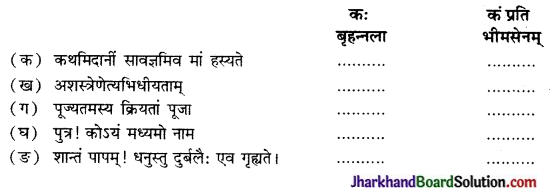
उत्तरम् :

6. अधोलिखितानि स्थूलानि सर्वनामपदानि कस्मै प्रयुक्तानि?
(नीचे लिखे मोटे छपे सर्वनाम शब्दों का प्रयोग किसके लिए किया गया है?)
(क) वाचालयतु एनम् आर्यः।
(ख) किमर्थं तेन पदातिना गृहीतः?
(ग) कथं न माम् अभिवादयसि?
(घ) मम तु भुजौ एव प्रहरणम्।
(ङ) अपूर्व इव ते हर्षो ब्रूहि केन विस्मितः?
उत्तरम् :
(क) अभिमन्युम्
(ख) भीमसेनेन
(ग) राजानम्
(घ) भीमसेनस्य
(ङ) भटस्य।

7. (अ) श्लोकानाम् अपूर्णः अन्वयः अधोदत्तः। पाठमाधृत्य रिक्तस्थानानि पूरयत
(श्लोकों का अधूरा अन्वय नीचे दिया है। पाठ के आधार पर रिक्तस्थानों की पूर्ति कीजिए-)
(क) पार्थं पितरं मातुलं …………… च उद्दिश्य कृतास्त्रस्य तरुणस्य …………….. युक्तः ।
(ख) कण्ठश्लिष्टेन ……….. जरासन्धं योक्त्रयित्वा तत् असा………… कृत्वा (भीमेन) कृष्णः अतदर्हतां नीतः।
(ग) रुष्यता …………. रमे। ते क्षेपेण न रुष्यामि, किं ………… अहं नापराद्धः, कथं (भवान्) तिष्ठति, यातु इति।
(घ) पादयोः निग्रहोचितः समुदाचारः…………. । बाहुभ्याम् आहतम् (माम्) …………. बाहुभ्याम् एव नेष्यति।
उत्तरम् :
(क) जनार्दनम्, युद्धपराजयः
(ख) बाहुना, कर्म
(ग). भवता, उक्त्वा
(घ) क्रियताम्, भीमः।
(आ) अधोलिखितेभ्यः पदेभ्यः उपसर्गान् विचित्य लिखत –
(नीचे लिखे पदों से उपसर्गों को चनकर लिखो-)

JAC Class 9th Sanskrit प्रत्यभिज्ञानम् Important Questions and Answers
प्रश्न: 1.
भटः कथं हर्षितः विस्मितः च आसीत्? (भट क्यों प्रसन्न और आश्चर्यचकित था?)
उत्तरम् :
सौभद्रो ग्रहणं गतः, अनेन कारणेन स हर्षितः विस्मितः चासीत्। (अभिमन्यु पकड़ा गया, इस कारण से वह प्रसन्न और आश्चर्यचकित था।)
प्रश्न: 2.
उमावेषमाश्रितो हरः इव कः विभाति? (पार्वती के वेष का आश्रय लिए शिव की तरह कौन शोभित है?)
उत्तरम् :
उमावेषमाश्रित्य हरः इव अर्जुनः शोभते। (पार्वती के वेष का आश्रय लिये शिव की तरह अर्जुन शोभा देता है।)
प्रश्न: 3.
अभिमन्युः किं विचिन्त्यात्मानं तिरस्कृतम् अनुभवति? (अभिमन्यु क्या सोचकर अपने को तिरस्कृत अनुभव करता है?)
उत्तरम् :
स चिन्तयति यद् अहं शत्रुवशं गतः अतएव तिरस्कृतम् अनुभवति। (वह सोचता है कि मैं शत्रु के वश में पड़ गया हूँ, इसीलिए तिरस्कृत अनुभव करता है।)

प्रश्न: 4.
कः कम् अपृच्छत्-अपि कुशली देवकीपुत्रः केशव? इति ? (क्या देवकी पुत्र कृष्ण कुशल हैं? यह प्रश्न किसने किससे पूछा?)
उत्तरम् :
अपि कुशली देवकीपुत्रः केशवः? इति बृहन्नला (अर्जुनः) अभिमन्युमपृच्छत्। (क्या देवकी पुत्र कृष्ण कुशल हैं? यह बृहन्नला (अर्जुन) ने अभिमन्यु से पूछ।)
प्रश्न: 5.
सौभद्रानुसारेण कुरुकुले किं कर्तुमनुचितम्? (अभिमन्यु के अनुसार कुरुकुल में क्या करना अनुचित है?)
उत्तरम् :
सौभद्रानुसारेण कुरुकुले आत्मस्तवम् अनुचितम्। (अभिमन्यु के अनुसार कुरुकुल में आत्मप्रशंसा करना अनुचित है।)
प्रश्नः 6.
अभिमन्युः भीमं कथं न प्राहरत्?(अभिमन्यु ने भीम पर प्रहार क्यों नहीं किया?)
उत्तरम् :
भीमः अशस्त्रः आसीत्। अतः स तं न प्राहरत्। (भीम शस्त्रहीन था। इसलिए उसने उस पर प्रहार नहीं किया।)
प्रश्नः 7.
भीमसेनेन कृष्णः अतदर्हतां कथं नीतः? (भीमसेन कृष्ण को अयोग्यता की ओर कैसे ले गया?)
उत्तरम् :
भीमसेनेन जरासन्धं हत्वा कृष्णः अतदर्हतां नीतः यतः कृष्णः (स्वयं) तं हन्तुमैच्छत्। (भीमसेन जरासन्ध को मारकर कृष्ण को अयोग्यता की ओर ले गया, क्योंकि कृष्ण (स्वयं) उसको मारना चाहते थे।)

प्रश्न: 8.
‘प्रत्यभिज्ञानम्’ इति नाट्यांशे नरेन्द्रेण महानसे कः नियुक्तः आसीत् ? (‘प्रत्यभिज्ञानम्’ नाट्यांश में राजा द्वारा रसोई में किसे नियुक्त किया था?)
उत्तरम् :
महानसे वल्लभवेषधारी भीमसेनः नियुक्त आसीत्। (रसोई में वल्लभ का वेष धारण किया भीमसेन नियुक्त कर रखा था?)
प्रश्न: 9.
अभिमन्युः कथं केन गृहीतः? (अभिमन्यु कैसे किसने पकड़ा?)
उत्तरम् :
अभिमन्युः भीमसेनेन रथमासाद्य बाहुभ्याम् गृहीतः। (अभिमन्यु भीमसेन द्वारा रथ के पास जाकर भुजाओं से पकड़ा गया।)
प्रश्न: 10.
अभिमन्युः तिरस्कारस्य किं कारणं चिन्तयति? (अभिमन्यु तिरस्कार का क्या कारण सोचता है?)
उत्तरम् :
अहं शत्रुवशंगत: अतः नामाभिः अभिभाष्ये तिरस्क्रिये च। (मैं शत्रु के काबू में हूँ? अतः नाम लेकर बोला जा रहा है तथा तिरस्कार किया जा रहा है।)
प्रश्न: 11.
सावज्ञं कः हस्यते? (अवज्ञापूर्वक किस पर हँसा जा रहा है?)
उत्तरम् :
सावज्ञं अभिमन्युः हस्यते। (अभिमन्यु पर अवज्ञा के साथ उपहास किया जाता है।)

प्रश्न: 12.
‘अहम् अस्य दर्पशमनं करोमि’ इति कस्य वचनम्? (मैं इसका घमण्ड शान्त करूंगा। यह किसका वचन है?)
उत्तरम :
अहम् अस्य दर्पशमनं करोमि इति राज्ञ वाक्य। (मैं इसका दर्प शान्त करता हूँ? यह राजा का वाक्य है।) रेखांकितानि पदानि आधृत्य प्रश्ननिर्माणं कुरुत-(रेखांकित शब्दों को आधार पर प्रश्ननिर्माण कीजिए-)
प्रश्न: 1.
सौभद्रो ग्रहणं गतः। (सुभद्रासुत पकड़ा गया।) उत्तरम् : कः ग्रहणं गतः? (कौन पकड़ा गया?)
प्रश्न: 2.
एष नरेन्द्रेण विनियुक्तो महानसे। (यह राजा द्वारा रसोई में नियुक्त किया गया है।)
उत्तरम् :
एषः नरेन्द्रेण कुत्र नियुक्तः? (यह राजा द्वारा कहाँ नियुक्त किया गया?)
प्रश्न: 3.
बृहन्नला वल्लभौ परस्परम् अवलोकयतः। (बृहन्नला और वल्लभ आपस में देखते हैं।)
उत्तरम् :
कौ परस्परम् अवलोकयतः? (कौन आपस में देखते हैं ?)

प्रश्न: 4.
अस्माकं कुले आत्मस्तवं कर्तुमनुचितम्। (हमारे कुल में अपनी प्रशंसा करना अनुचित है।)
उत्तरम् :
अस्माकं कुले किम् कर्तुम् अनुचितम्? (हमारे कुल में क्या करना अनुचित है?)
प्रश्न: 5.
धनुस्तु दुर्बलैः एव गृह्यते। (धनुष तो दुर्बलों द्वारा ही ग्रहण किया जाता है।)
उत्तरम् :
धनुस्तु कैः एव गृह्यते? (धनुष किसके द्वारा ही ग्रहण किया जाता है?)
प्रश्नः 6.
भीमस्य भुजौ एव प्रहरणम्। (भीम की तो भुजाएँ ही शस्त्र हैं।)
उत्तरम् :
कस्य भुजौ एव प्रहरणम् ? (किसकी भुजाएँ ही शस्त्र हैं? )
प्रश्न: 7.
पूज्यतमस्य क्रियतां पूजा (पूज्यतम की पूजा की जानी चाहिए।)
उत्तरम् :
कस्य क्रियतां पूजा? (किसकी पूजा की जानी चाहिए?)
प्रश्नः 8.
दुर्योधनादिना राजः विराटस्य गावः अपहता। (दुर्योधन आदि के द्वारा विराट की गायों का अपहरण कर लिया गया।)
उत्तरम् :
दुर्योधनादिना कस्य गावः अपहृता? (दुर्योधन आदि के द्वारा किसकी गायों का अपहरण कर लिया गया?)

प्रश्नः 9.
अशस्त्रे वीराः न प्रहरन्ति। (निःशस्त्र पर वीर प्रहार नहीं करते।)
उत्तरम् :
वीराः केषु न प्रहरन्ति? (वीर किन पर प्रहार नहीं करते हैं?)
प्रश्न: 10.
मां वञ्चयित्वा गृहीतवान्। (मुझे छलकर पकड़ लिया।)
उत्तरम् :
मां कथं गृहीतवान्? (मुझे कैसे पकड़ लिया गया?).
कथाक्रम-संयोजनम् ।
अधोलिखितानि वाक्यानि क्रमेण लिखित्वा कथाक्रम-संयोजनं कुरुत (नीचे लिखे वाक्यों को क्रम से लिखकर कथा-क्रम-संयोजन कीजिए-)
(1) अभिमन्युः स्व पितॄनवलोक्य प्रसन्नः सन् सर्वान् क्रमशः अभिवादयति पाण्डवाः च तम् आलिङ्गन्ति।
(2) उत्तरः रहस्यमुद्घाटयति।
(3) ततः एव विराटपुत्रः उत्तरः आयाति।
(4) पाण्डवाः अभिमन्युम् उपहसन्ति सः च क्रुध्यति।
(5) अभिमन्युः अनभिज्ञत्वात् तैः सह उग्रं व्यवहरति।
(6) अभिमन्युः विराटसैनिकैः सह योद्धमागच्छत्। तत्र छद्मवेषधारिणा भीमेन निग्रहीतः राज्ञः समीपं नीतः।
(7) कौरवैः सह विराटसेनायाः युद्धोऽभवत्।
(8) कौरवाः विराटस्य धेनूनाम् अपहरणम् अकुर्वन्।
उत्तर :
कथा-क्रम-संयोजनम् –
(1) कौरवाः विराटस्य धेनूनाम् अपहरणम् अकुर्वन्।
(2) कौरवैः सह विराटसेनायाः युद्धोऽभवत्।
(3) अभिमन्युः विराटसैनिकैः सह योद्धमागच्छत्। तत्र छद्मवेषधारिणा भीमेन निग्रहीतः राज्ञः समीपं नीतः।
(4) पाण्डवाः अभिमन्युम् उपहसन्ति सः च क्रुध्यति ।
(5) अभिमन्युरनभिज्ञत्वात् तैः सह उग्रं व्यवहरति।
(6) ततः एव विराटपुत्रः उत्तरः आयाति।
(7) उत्तरः रहस्यमुद्घाटयति।
(8) अभिमन्युः स्वपितृनवलोक्य प्रसन्नः सन् सर्वान् क्रमशः अभिवादयति पाण्डवाः च तम् आलिङ्गन्ति।

योग्यताविस्तारः
कवि परिचय – संस्कृत नाटककारों में महाकवि भास का नाम अग्रगण्य है। भासरचित तेरह रूपक (नाटक) निम्नलिखित दूतवाक्यम्, कर्णभारम्, दूतघटोत्कचम्, ऊरुभङ्गम्, मध्यमव्यायोगः पञ्चरात्रम्, अभिषेकनाटकम्, बालचरितम्, अविमारकम्, प्रतिमानाटकम्, प्रतिज्ञायौगन्धरायणम्, स्वप्नवासवदत्तम् तथा चारुदत्तम्।
ग्रन्थ-परिचय – पञ्चरात्रम् की कथावस्तु महाभारत के विराट पर्व पर आधारित है। पाण्डवों के अज्ञातवास के समय दुर्योधन एक यज्ञ करता है और यज्ञ की समाप्ति पर आचार्य द्रोण को गुरुदक्षिणा देना चाहता है। द्रोण गुरुदक्षिणा के रूप में पाण्डवों का राज्याधिकार चाहते हैं। दुर्योधन कहता है कि यदि गुरु द्रोणाचार्य पाँच रातों में पाण्डवों का पता लगा दें तो उन (पाण्डवों) की पैतृक सम्पत्ति का भाग उन पाण्डवों को दिया जा सकता है। इसी आधार पर इस नाटक का नाम ‘पञ्चरात्रम्’।
भावविस्तारः
तरुणस्य कृतास्त्रस्य युक्तो युद्धपराजयः – अज्ञातवास में बृहन्नला के रूप में अर्जुन को बहुत समय के बाद पुत्र-मिलन का अवसर प्राप्त हुआ। वह अपने पुत्र (अभिमन्यु) से बात करना चाहता है परन्तु (अपने अपहरण से) क्षुब्ध अभिमन्यु उनके साथ बात करना ही नहीं चाहता। तब अर्जुन उसे उत्तेजित करने की भावना से इस प्रकार के व्यङ्ग्यात्मक वचन कहते हैं –
तुम्हारे पिता अर्जुन हैं, मामा श्रीकृष्ण हैं तथा तुम शस्त्रविद्या से सम्पन्न होने के साथ ही साथ तरुण भी हो, तुम्हारे लिए युद्ध में परास्त होना उचित है।
मम तु भुजौ एव प्रहरणम् – अभिमन्यु क्षुब्ध है कि उसे धोखे से शस्त्रविहीन भीम ने निगृहीत किया है। भीम इसका स्पष्टीकरण करता है कि अस्त्र-शस्त्र तो दुर्बल व्यक्तियों द्वारा ग्रहण किये जाते हैं। मेरी तो दो भुजायें ही मेरा शस्त्र हैं। अतः मुझे किसी अन्य आयुध की आवश्यकता नहीं। इस प्रकार का भाव अन्य नाटकों में भी उपलब्ध है, जैसे –
(क) अयं तु दक्षिणो बाहुरायुधं सदृशं मम। (यह मेरी दाहिनी भुजा तो (मेरी) शस्त्र के समान है।)(मध्यमव्यायोगः)
(ख) भीमस्यानुकरिष्यामि शस्त्रं बाहुभविष्यति। (मैं भीम का अनुकरण करूँगा, भुजा शस्त्र हो जायेगी।)(मृच्छकटिकम्)
(ग) वयमपि च भुजायुद्धप्रधानाः। (और हम लोग भी भुजाओं से युद्ध करने की प्रधानता वाले हैं।) (अविमारकम्)
नीतः कृष्णोऽतदहताम् – श्रीकृष्ण ने जरासन्ध के जामाता (दामाद) कंस का वध किया था। इससे क्रुद्ध जरासन्ध ने यदुवंशियों के विनाश की प्रतिज्ञा की थी। इसलिए उसने बार-बार मथुरा पर आक्रमण भी किया था। उसने श्रीकृष्ण को कई बार पकड़ा भी परन्तु किसी-न-किसी प्रकार श्री कृष्ण वहाँ से निकल गये। वस्तुतः उचित अवसर पाकर श्रीकृष्ण जरासन्ध को मारना चाहते थे। परन्तु भीम ने जरासन्ध का वध करके उनकी पात्रता स्वयं ले ली। जो कार्य श्रीकृष्ण द्वारा करणीय था उसे भीमसेन ने कर दिया और श्रीकृष्ण को जरासन्ध के वध का अवसर ही नहीं दिया।
कोऽयं मध्यमो नाम? – यहाँ मध्यम शब्द का प्रयोग भास द्वारा भीम के लिए किया गया है। भास के नाटकों में सर्वत्र भीम के लिए ‘मध्यम’ शब्द का प्रयोग किया गया है। उन्होंने ‘मध्यमव्यायोग’ रूपक (नाटक) की रचना की जिसमें मध्यम पाण्डव अर्थात् भीम को नायक बनाया है।

‘क्तवतु’ भी भूतकालिक प्रत्यय है। इसका प्रयोग सदैव कर्तृवाच्य में होता है। क्तवतु प्रत्ययान्त शब्द भी तीनों लिङ्गों में होते हैं।
यथा-पठ् + क्तवतु = पठितवत् (पढ़ा)

वाच्यपरिवर्तनम्

योग्यताविस्तार पर आधारित प्रश्नोत्तर –
प्रश्न 1.
महाकवि भास के कुल कितने नाटक उपलब्ध हैं?
उत्तर :
महाकवि भास के कुल 13 नाटक उपलब्ध हैं।

प्रश्न 2.
भास के महाभारत पर आधारित किन्हीं 5 नाटकों के नाम लिखिये।
उत्तर :
दूतवाक्यम्, कर्णभारम्, ऊरूभङ्गम्, पञ्चरात्रम्, दूतघटोत्कचम्।
प्रश्न 3.
दुर्योधन से यज्ञ-दक्षिणा में आचार्य द्रोण ने क्या माँगा?
उत्तर :
दुर्योधन से यज्ञ-दक्षिणा में आचार्य द्रोण ने पाण्डवों का राज्याधिकार माँगा।
प्रश्न 4.
मध्यम व्यायोग का नायक कौन है?
उत्तर :
मध्यम व्यायोग का नायक मध्यम पाण्डव भीमसेन है।
प्रश्न 5.
इस नाटक का शीर्षक ‘पञ्चरात्रम्’ क्यों चुना?
उत्तर :
दुर्योधन ने कहा यदि गुरु द्रोणाचार्य पाँच रातों में पाण्डवों का पता लंगा दें तो पाण्डवों की पैतृक सम्पत्ति का भाग पाण्डवों को दिया जा सकता है। इसी आधार पर इस नाटक का नाम ‘पञ्चरात्रम्’ है।
प्रश्न 6.
निम्न वाक्यों में कोष्ठक में दिए शब्दों के उचित रूप बनाकर रिक्त स्थान की पूर्ति कीजिए।
(क) अलं……………। (प्रलाप).
उत्तर :
प्रलापेन
(ख) रामः…………अलम। (रावण)
उत्तर :
रावणाय

(ग) अलं………… । (विवाद)
उत्तर :
विवादेन
(घ) अर्जुनः………….अलम्। (कर्ण)
उत्तर :
कर्णाय
(ङ) अहं…………..अलम्। (युष्मद्)
उत्तर :
तुभ्यम्
(च) इदं भोजनम्……………अलम्। (अस्मद्)
उत्तर :
मह्यम्
प्रश्न 7.
निम्न वाक्यों को वाच्य परिवर्तन करके लिखिए –
(क) बालकः पुस्तकं पठति।
(ख) अहं पत्रं लिखामि।
(ग) तेन भोजनं खाद्यते।
(घ) मया जलं पीयते।
(ङ) तया कथा श्रूयते।
(च) छात्रैः हस्यते।
उत्तर :
(क) बालकेन पुस्तकं पठ्यते।
(ख) मया पत्रं लिख्यते।
(ग) सः भोजनं खादति।
(घ) अहं जलं पिबामि।
(ङ) सा कथां शृणोति।
(च) छात्रः हसति।

प्रश्न 8.
निम्नलिखित पदों में प्रकृति प्रत्यय पृथक्-पृथक् कीजिए –
पठितः, गतः, हृष्टा, दुष्टः, गतवान्, हसितवान्, दृष्टवान्, नीतः
उत्तरम् :

प्रत्यभिज्ञानम् Summary and Translation in Hindi
पाठ परिचय – संस्कृत साहित्य में भास प्रथम नाटककार के रूप में जाने जाते हैं। महाकवि भास ने कुल 13 नाटकों की रचना की। ‘पञ्चरात्रम्’ नाटक उन्हीं में से एक है। प्रस्तुत पाठ भासरचित ‘पञ्चरात्रम्’ नाटक से सम्पादित कर लिया गया है। इसका कथानक महाभारत के विराट पर्व से लिया गया है। पाण्डवों के अज्ञातवास के समय दुर्योधन एक यज्ञ करता है और यज्ञ की समाप्ति पर आचार्य द्रोण को गुरुदक्षिणा देना चाहता है। द्रोण गुरुदक्षिणा के रूप में पाण्डवों का राज्याधिकार चाहते हैं। दुर्योधन कहता है कि यदि गुरु द्रोणाचार्य पाँच रातों में पाण्डवों का पता लगा दें तो पाण्डवों की पैतृक सम्पत्ति का भाग पाण्डवों को दिया जा सकता है। इसी आधार पर इस नाटक का नाम पञ्चरात्रम् है। भास के 13 नाटकों के नाम हैं – (1) दूतवाक्यम् (2) कर्णभारम् (3) दूतघटोत्कचम् (4) ऊरुभङ्गम् (5) मध्यमव्यायोगः (6) पञ्चरात्रम् (7) अभिषेकनाटकम् (8) बालचरितम् (9) अविमारकम् (10) प्रतिमानाटकम् (11) प्रतिज्ञायौगन्धरायणम् (12) स्वप्नवासवदत्तम् तथा (13) चारुदत्तम्।
पाठ का सारांश – दुर्योधन आदि कौरव वीरों ने राजा विराट की गायों का अपहरण कर लिया। विराट-पुत्र उत्तर बृहन्नला (छद्मवेषी अर्जुन) को सारथी बनाकर कौरवों से युद्ध करने जाता है। कौरवों की ओर से अभिमन्यु (अर्जुन-पुत्र) .. भी युद्ध करता है। युद्ध में कौरवों की पराजय होती है। इसी बीच विराट को सूचना मिलती है कि वल्लभ (छद्मवेषी भीम)
ने रणभूमि में अभिमन्यु को पकड़ लिया है। अभिमन्यु भीम तथा अर्जुन को नहीं पहचान पाता है और उनसे उग्रतापूर्वक बातचीत करता है। दोनों अभिमन्यु को महाराज विराट के समक्ष प्रस्तुत करते हैं। अभिमन्यु उन्हें प्रणाम नहीं करता। उसी समय राजकुमार उत्तर वहाँ पहुँचता है जिसके रहस्योद्घाटन से अर्जुन तथा भीम आदि पाण्डवों के छद्मवेष का उद्घाटन हो जाता है।
[मूलपाठः,शब्दार्यः,सप्रसंग हिन्दी अनुवादः,सप्रसंगसंस्कृत-व्यारव्याःअवबोधनकार्यम्च।]
1. भटः – जयतु महाराजः।
राजा – अपूर्व इव ते हर्षो ब्रूहि केनासि विस्मितः?
भटः – अश्रद्धेयं प्रियं प्राप्तं सौभद्रो ग्रहणं गतः॥
राजा – कथमिदानी गृहीतः?
भटः – रथमासाद्य निश्शङ्कं बाहुभ्यामवतारितः।
राजा – केन?
भटः – यः किल एष नरेन्द्रेण विनियुक्तो महानसे। (अभिमन्यमुद्दिश्य) इत इतः कुमार!
अभिमन्युः – भोः को नु खल्वेष:? येन भुजैकनियन्त्रितो बलाधिकेनापि न पीडितः अस्मि।
बृहन्नला – इत इत: कुमारः।
अभिमन्युः – अये! अयमपरः कः विभात्युमावेषमिवाश्रितो हरः।
बृहन्नला – आर्य, अभिभाषणकौतूहलं मे महत्। वाचालयत्वेनमार्यः।
वल्लभः – (अपवार्य) बाढम् (प्रकाशम्) अभिमन्यो!
अभिमन्युः – अभिमन्युर्नाम?
वल्लभः
रुष्यत्येष मया, त्वमेवैनमभिभाषय। बृहन्नला
अभिमन्यो! अभिमन्युः
कथं कथम्। अभिमन्यु माहम्। भोः! किमत्र विराटनगरे क्षत्रियवंशोद्भूताः नीचैः अपि नामभिः अभिभाष्यन्ते अथवा अहं शत्रुवशं गतः। अतएव तिरस्क्रियते।

शब्दार्था: – जयतु = विजयताम् (जय हो), महाराजः = देवः (महाराज), अपूर्व इव = अविद्यमानः पूर्ववत् इव (जो पहले न हुआ हो, उसके समान), ते हर्षः = तव प्रसन्नता (तेरी खुशी), ब्रूहि = कथय (कहो), केनासि = केन कारणेन असि (किस कारण से हो), विस्मितः = आश्चर्यचकितः (अचम्भित), अश्रद्धेयम् = न श्रद्धेयम्/अविश्वसनीयम् (श्रद्धा के अयोग्य/विश्वास न करने योग्य), प्रियं प्राप्तम् = इष्टम् (वृत्तं) लब्धं [प्रिय (समाचार) प्राप्त हुआ है],
सौभद्रोः ग्रहणं गतः = अधिगृहीतः सुभद्रानन्दनः अभिमन्युः (बन्दी बनाया हुआ सुभद्रा-पुत्र अभिमन्यु), कथमिदानी गृहीतः = कथमधुनाधिगृहीतः (अब यह कैसे पकड़ा गया), रथमासाद्य = स्यन्दनं प्राप्य/आरुह्य (रथ पाकर/पहुँचकर/चढ़कर), निश्शङ्कम् = शङ्कया रहितम्/संशयविहीनं (शङ्का/सन्देहरहित को), बाहुभ्यामवतारितः = भुजाभ्याम् अवरोहितः (भुजाओं से उतार लिया), केन = किसके द्वारा, यः = जो, किल = वस्तुतः (सचमुच),
एषः = अयम् (यह), नरेन्द्रेण = नृपेण (राजा द्वारा), विनियुक्तो = विशिष्ट नियुक्त (विशेष रूप से नियुक्त), महानसे = भोजनालये, पाकशालायाम् (रसोई में), अभिमन्युमुद्दिश्य = सौभद्रप्रति (अभिमन्यु को लक्ष्य करके), इत इतः कुमारः = अत्र, अत्र एहि राजकुमारः (इधर-उधर माइए राजकमार), भोः को न खल्वेषः = रे वस्तुतः अयं कः (अरे, वास्तव में यह कौन है?), येन = जिसके द्वारा, भुजैकनियन्त्रितो = एकेन एव बाहुना निरुद्धः/संयतः (एक ही भुजा से रोका/पकड़ा हुआ), बलाधिकेनापि = शक्तिप्रभूतेन, बलवत्तरेण (अधिक बलवान् के द्वारा भी), न पीडितः अस्मि = अपीडितः, न क्लिष्टः अस्मि (पीड़ित नहीं हूँ।),
इत इतः = अत्र-अत्र (इधर-इधर), कुमारः = बाल राजकुमारः (राजकुमार), अये! = अरे (अरे), अयमपरः दूसरा), कः = कौन, विभाति = शोभते (सुशोभित होता है), उमावेषमिवाश्रितो हरः = पार्वत्याः रूपधारिणा शिवेन इव (पार्वती का वेष धारण किये हुए शिव की तरह), आर्य = श्रेष्ठ (आर्य), अभिभाषण = वक्तुं (बोलने की), कौतूहलम् = औत्सुक्यम् (उत्सुकता), मे = मम (मेरी), महत् = अधिकं (बहुत), वाचालयत्वेनमनार्यः = वक्तुं प्रेरयतु इमं श्रीमान् (श्रीमान् ने की प्रेरणा प्रदान करें),अपवार्य = मुखं दूरीकृत्य (मुँह छुपाकर/ढककर/हटाकर), बाढम् = श्रेष्ठम् (बढ़िया/अच्छा), प्रकाशम् = सार्वजनिकरूपेण (खुले में/ सबके सामने),
अभिमन्यो = रे सौभद्र !/रे अभिमन्यो ! (हे अभिमन्यु!), अभिमन्यु म = अभिमन्यु नाम से, रुष्यत्येष मया = एषः मह्यं क्रुध्यति (मुझसे यह क्रोधित होता है), त्वमेवैनम् = भवान् एव इमम् (आप ही इसको), अभिभाषय = वादय, व्याख्यातुं प्रेरय (बुलवाइये), कथं कथम् = कैसे-कैसे, क्या-क्या, अभिमन्यु माहम् = मैं अभिमन्यु नाम से, भोः! = रे! (अरे!), किमत्र विराटनगरे = किमस्मिन् विराटनगरे (क्या इस विराट नगर में), क्षत्रियवंशोभूताः = राजन्यकुलजाताः (क्षत्रिय वंश में पैदा हुए), नीचैः अपि = अधमैः अपि (नीच लोगों द्वारा न), नामभिः = अभिधानैः (नाम लेकर/नाम से),
अभिभाष्यन्ते = वादयन्ते (बुलवाये जाते हैं), अथवा = उत वा (या), अहं शत्रुवशं गतः = अहम् अरीणां मध्येऽवरुद्धोऽस्मि (मैं शत्रुदल के मध्य घिर गया हूँ/वश में हो गया हूँ), अतएव = अतः, अनेनैव कारणेन (इसी वजह से), तिरस्क्रियते = अवमन्यते/उपेक्ष्यते (तिरस्कार किया जा रहा है/उपेक्षा की जा रही है)।

हिन्दी-अनुवादः
सन्दर्भ – प्रस्तुत नाट्यांश हमारी पाठ्यपुस्तक ‘शेमुषी’ के ‘प्रत्यभिज्ञानम्’ पाठ से लिया गया है। यह पाठ भास कवि के ‘पञ्चरात्रम्’ नाटक का सम्पादित रूप है।
प्रसङ्ग – इस नाट्यांश में बन्दी बनाये गये अभिमन्यु के साथ भीम और अर्जुन का संवाद चल रहा है। क्रुद्ध अभिमन्यु पहचान न पाने के कारण उनके प्रति अविनीत व्यवहार करता है। भीम और अर्जुन भी उसकी उपेक्षा करते हैं।
अनुवाद –
भट – महाराज की जय हो।
राजा – पहले कभी न देखी-सी प्रसन्नता है तुम्हारी, कहिये, किस कारण आश्चर्यचकित हैं?
भट – विश्वास न करने योग्य प्यारा (समाचार) मिला है। सुभद्रानन्दन अभिमन्यु पकड़ लिया गया अर्थात् बन्दी बना लिया गया।
राजा – अब यह कैसे पकड़ा गया?
भट – निस्सन्देह रथ पर पहुँचकर भुजाओं से उतार लिया।
राजा – किसके द्वारा?
भटः – सचमुच जो इस राजा द्वारा रसोई में विशेषरूप से नियुक्त है। (अभिमन्यु की ओर संकेत करते हुए, इधर-उधर आइये राजकुमार)।
अभिमन्युः – अरे, वास्तव में यह कौन है? जिसके द्वारा एक भुजा से पकड़ा हुआ अधिक बल होने पर भी मैं पीड़ित नहीं हुआ हूँ।
बृहन्नला – इधर, इधर आओ, कुमार।
अभिमन्यु – अरे यह दूसरा कौन पार्वती का वेष धारण किए हुए शिव की तरह शोभा दे रहा है।
बृहन्नला – आर्य, मेरी (इससे) बोलने की प्रबल इच्छा है। आर्य इसे बोलने के लिए प्रेरित करें।
वल्लभ – (दूर हटकर) बहुत अच्छा (सबके सामने) अभिमन्यु!
अभिमन्यु – (क्या) अभिमन्यु (इस नाम से व्यवहार करता है)?
वल्लभ – यह मुझसे नाराज़ है, तुम्हीं इसे बोलने के लिए प्रेरित कीजिए।
बृहन्नला – अभिमन्यु!
अभिमन्यु – क्या, क्या? मैं अभिमन्यु नाम वाला हूँ? अरे, क्या यहाँ विराट नगर में क्षत्रिय वंश में पैदा हुए लोगों को नीच लोगों (सैनिकों आदि) के द्वारा भी नाम लेकर बुलवाये जाते हैं अथवा मैं शत्रुओं के वश में हो गया हूँ, इसीलिए तिरस्कार किया जा रहा है।
संस्कत-व्याख्याः –
सन्दर्भ: – नाट्यांशोऽयम् अस्माकं पाठ्यपुस्तकस्य ‘शेमुष्याः’ ‘प्रत्यभिज्ञानम्’ इति पाठात् उद्धृतः। पाठोऽयं भासकवेः ‘पञ्चरात्रम्’ नाटकस्य सम्पादितं रूपं वर्तते। (प्रस्तुत नाट्यांश हमारी पाठ्यपुस्तक ‘शेमुषी’ के ‘प्रत्यभिज्ञानम्’ पाठ से लिया गया है। यह पाठ भास कवि के ‘पञ्चरात्रम्’ नाटक का सम्पादित रूप है।) – प्रसङ्गः-नाट्यांशेऽस्मिन् निगृहीतेन अभिमन्युना सह भीमार्जुनयोः संवादः प्रवर्तते। क्रुद्धः अभिमन्युः अनभिज्ञानात् तौ प्रति विनयहीनं व्यवहारं करोति। भीमार्जुनौ अपि तम् उपेक्षते। (इस नाट्यांश में पकड़े हुए अभिमन्यु के साथ भीम और अर्जुन कद्ध अभिमन्य न यह जानने के कारण उन दोनों के साथ विनम्रता-विहीन व्यवहार करता है। भीम और अर्जुन भी उसकी उपेक्षा करते हैं।)

व्याख्याः
भटः – विजयतां देवः। (महाराज की जय हो।)
राजा – अविद्यमाना पूर्वम् इव तव प्रसन्नता, कथय, केन कारणेन आश्चर्यचकितोऽसि। (पहले न देखी गई (अपूर्व) खुशी है, कहिये कैसे आश्चर्यचकित हो रहे हो?)
भटः – न श्रद्धेयम् इष्टं (वृत्तं) लब्धम्। अभिमन्युः निगृहीतः। (विश्वास न करने योग्य प्रिय समाचार प्राप्त हुआ है। अभिमन्यु बन्दी बना लिया।)
राजा – कथम् अधुना निगृहीतः? (अब यह कैसे पकड़ा गया?)
भटः – शङ्कया रहितं स्यन्दनम् आरुह्य (प्राप्य) भुजाभ्याम् अवरोहितः। (निशङ्क रथ पर चढ़कर भुजाओं से उतार लिया सबके सामने।)
राजा – केन? (कैसे)
भटः – यः वस्तुतः अयम् नृपेण विशिष्ट नियुक्त पाकाशालायाम् (सौभद्रं प्रति) अंत्र अत्र इति राजकुमारः। (वस्तुतः जो यह राजा ने पाकशाला में विशिष्ट रूप से नियुक्त किया है (अभिमन्यु के प्रति) यहाँ यहाँ आइए राजकुमार।)
अभिमन्यु – अरे कोऽयं वस्तुतः? येन एकेन बाहुना संयतः बलवत्तरेण अपि न क्लिष्टोऽस्मि। (अरे! वास्तव में यह कौन है जिसने एक ही भुजा से पकड़ा हुआ होने पर अधिक बलवान् होने पर भी कष्ट नहीं दिया गया।)
बृहन्नला – अत्र एहि, अत्र एहि, कुमार। (यहाँ आओ, यहाँ आओ राजकुमार।)
अभिमन्युः – अरे! एषः इतरः कः पार्वत्याः रूपधारिणा शिवेन इव शोभते? (अरे इधर यह कौन पार्वती का वेष धारण किए हुए शिव की तरह शोभा दे रहा है?)
बृहन्नला – आर्य, मम वक्तुम् औत्सुक्यम् अधिकम् । श्रीमान् इमं वक्तुं प्रेरयतु। (आर्य, मुझे बात करने की बहुत उत्सुकता है। श्रीमान् इसे बोलने के लिए प्रेरित करें।)
वल्लभः – (दूरीकृत्य) श्रेष्ठम् (सर्वेषां समक्षे) अभिमन्यो! ((दूर करके) उत्तम (सबके सामने) अभिमन्यु!)
अभिमन्युः – (किम्) अभिमन्युः (इति नाम्ना मां व्यवहरति)? (क्या? अभिमन्यु, मुझे नाम लेकर बुला रहे
वल्लभः – अयं मह्यं क्रुध्यति अतः भवान् एव इमं वक्तुं प्रेरयतु। (यह मुझसे नाराज है अतः आप ही इसे बोलने के लिए प्रेरित करें।) बृहन्नला – अभिमन्यो! (अभिमन्यु।)
अभिमन्युः – किं, किम् अहम् अभिमन्युरभिधः? अरे! किम् अस्मिन् विराटनगरे राजन्यकुलोत्पन्नाः अधमैः (सैनिकादिभिः) अपि अभिधानः वादयन्ते उत वा अहम् अरिदलस्याधिकार प्राप्तः। अत एव. तिरस्कारं विधीयते (क्रियते)। (क्या, क्या तो तेरा नाम अभिमन्यु है? अरे क्या इस विराट नगर में क्षत्रियों के कुल में पैदा हुए अधम बीच (सैनिक आदि द्वारा) भी नाम लेकर बोला जाता है अथवा मैं शत्रु पक्ष के अधिकार में हूँ, इसीलिए तिरस्कार किया जा रहा है।)
अवबोधन कार्यम्
प्रश्न 1.
एकपदेन उत्तरत- (एक शब्द में उत्तर दीजिए-)
(क) सौभद्रः कः? (सौभद्र कौन है? )
(ख) का इयं बृहन्नला? (यह बृहन्नला कौन है?)
प्रश्न 2.
पूर्णवाक्येन उत्तरत- (पूरे वाक्य में उत्तर दीजिए-)
(क) सौभद्रः कथं गृहीतः? (सौभद्र कैसे पकड़ा गया?)
(ख) अभिमन्युः भीमस्य विषये किं पृच्छति? (अभिमन्यु भीम के विषय में क्या पूछता है?)

प्रश्न 3.
यथानिर्देशम् उत्तरत-(निर्देशानुसार उत्तर दीजिए-)
(क) ‘पाकशालायाम्’ इति पदस्य स्थाने नाट्यांशे किं समानार्थी पदं प्रयुक्तम्?
(‘पाकशालायाम्’ पद के स्थान पर नाट्यांश में कौनसा पर्यायवाची शब्द प्रयोग किया गया है?)
(ख) ‘को नु खल्वेषः’ अत्र एषः इति सर्वनाम पदं कस्य संज्ञापदस्य स्थाने प्रयुक्तम्?
(‘को नु खल्वेषः’ यहाँ ‘एषः’ सर्वनाम पद किस संज्ञा पद के स्थान पर प्रयोग हुआ है।)
उत्तराणि :
(1) (क) अभिमन्युः (सुभद्रापुत्र अभिमन्यु)।
(ख) अर्जुनः (अर्जुन ही बृहन्नला के रूप में है)।
(2) (क) रथमासाद्य निःशङ्कं बाहुभ्यामवतारितः।
(ख) पर चढ़कर शंकारहित को भुजाओं से उतार लिया गया।)
(ख) को नु खल्वेषः? येन भुजैक नियन्त्रियतो बलाधिकेनापि न पीडितः अस्मि। (यह कौन है? जिसने एक हाथ से नियन्त्रित कर अधिक ताकत होते हुए भी मुझे पीड़ित नहीं किया?)
(3) (क) महानसे (भोजनशाला में)।
(ख) भीमसेनाय (भीमसेन के लिए।)
2. बहन्नला – अभिमन्यो! सुखमास्ते ते जननी ?
अभिमन्युः – कथं कथम् ? जननी नाम? किं भवान् मे पिता अथवा पितृव्यः? कथं मां पितृवदाक्रम्य स्त्रीगतां कृथां पृच्छति?
बृहन्नला – अभिमन्यो! अपि कुशली देवकीपुत्रः केशवः?
अभिमन्युः – कथं कथम्? तत्रभवन्तमपि नाम्ना। अथ किम् अथ किम्?
(वृहन्नलावल्लभौ परस्परमवलोकयतः)
अभिमन्युः – कथमिदानी सावज्ञमिव मां हस्यते?
बृहन्नला – न खलु किञ्चित्।
पार्थं पितरमुद्दिश्य मातुलं च जनार्दनम्।
तरुणस्य कृतास्त्रस्य युक्तो युद्धपराजयः॥
अभिमन्युः – अलं स्वच्छन्दप्रलापेन! अस्माकं कुले आत्मस्तवं कर्तुमनुचितम्। रणभूमौ हतेषु शरान् पश्य, मदृते अन्यत् नाम न भविष्यति।
बृहन्नला – एवं वाक्यशौण्डीर्यम्। किमर्थं तेन पदातिना गृहीतः?
अभिमन्युः – अशस्त्रं मामभिगतः। पितरम् अर्जुनं स्मरन् अहं कथं हन्याम्। अशस्त्रेषु मादृशाः न प्रहरन्ति। अतः अशस्त्रोऽयं मां वञ्चयित्वा गृहीतवान्।
राजा – त्वर्यतां त्वर्यतामभिमन्युः।

शब्दार्था: – अभिमन्यो! = सौभद्र! (अरे! अभिमन्यु!), सुखमास्ते = सकुशलमस्ति (सकुशल हैं), ते जननी = तव माता (तुम्हारी माता), कथं कथम् = किं किम् (क्या, क्या), जननी = माता (माताजी), किं भवान् = अपि त्वं (क्या तुम), मे = मम (मेरे), पिता अथवा पितृव्यः = जनकः जनकस्यभ्राता वा (पिता अथवा चाचा/ताऊ), कथं मां = कस्मान्माम् (कैसे मुझसे), पितृवदाक्रम्य = जनकेवाधिकृत्य (पिता की तरह अधिकार जमाते हुए), स्त्रीगताम् = नारीविषयकी (स्त्री से सम्बन्धित), कथाम् = वृत्तं (समाचार), पृच्छति = पृच्छति (पूछते हो), अभिमन्यो! = सौभद्र। (अभिमन्यु),
अपि = किम् (क्या), कुशली = सकुशलम् (सकुशल हैं), देवकीपुत्रः = देवकीनन्दनः (देवकीपुत्र), केशवः = कृष्णः (कृष्ण), कथं कथम्? = किं किम्? (क्या-क्या?), तत्रभवन्तमपि = तम् श्रीमन्तं श्रीकृष्णमपि (उन आदरणीय श्रीकृष्ण को भी), नाम्ना = अभिधानेन (नाम से सम्बोधित कर रहे हैं), अथ किम् अथ किम् = कथं नु वा आम् (क्यों नहीं, क्यों नहीं, हाँ जी, हाँ जी), बृहन्नलावल्लभौ = उभौ (बृहन्नला और वल्लभ दोनों), परस्परमवलोकयतः = अन्योऽन्यं पश्यतः (आपस में एक-दूसरे को देखते हैं), कथमिदानीम् = कस्मात् अधुना (कैसे अब), माम् = (मुझे)। सावज्ञमिव = अपमानेन सहितम् (उपेक्षा सहित), मां = (मुझे), हस्यते = उपहस्यते (उपहास किया जाता है), न खलु किञ्चित् = निश्चयेन किञ्चिदपि नास्ति (निश्चित ही कुछ भी नहीं है), पार्थम् = पृथानन्दनम् अर्जुनम् (पृथापुत्र अर्जुन को), पितुरसुद्दिश्य = पितुः उद्देश्य कृत्वा (पिता को लक्ष्य करके),
मातुलम् = मातुः भ्राता (मामा जी), च = (और), जनार्दनम् = श्रीमन्तं कृष्णम् (श्रीकृष्ण को), तरुणस्य = यौवनारूढस्य (जवान का), कृतास्त्रस्य = शस्त्रविद्यासम्पन्नस्य (शस्त्र विद्या सम्पन्न का), युक्तोः = उचितमेव (उचित ही है), युद्धपराजयः = सङ्ग्रामे पराभवः, (युद्ध में परास्त होना), अलम् = मा कुरु, (बस), स्वच्छन्द = असंयतः/स्वैरं (मनमानी), प्रलापेन = अनर्गलवादेन (व्यर्थ की बातें), अस्माकं कुले = अस्मत्कुले (हमारे कुल में), आत्मस्तवम् = आत्मश्लाघा (आत्मप्रशंसा), कर्तुम् = विधातुम् (करना), अनुचितम् = नोचितम् (उचित नहीं है), रणभूमौ = समराङ्गणे (युद्धक्षेत्र में),
हतेषु = शवेषु (मारे हुओं में), शरान् पश्य = बाणान् अवलोकय (बाणों को देखो), मदृते = मामन्तरेण, (मेरे अतिरिक्त), अन्यत् = अन्यः (कोई और), नाम = अभिधानम् (नाम), न भविष्यति = न वर्तिष्यते (नहीं . .. होगा), एवम् = अनेन प्रकारेण (इस प्रकार), वाक्यशौण्डीर्यम् = वाचिकं वीरत्वं (वाणी की वीरता, गाल बजाना), किमर्थम् = केन प्रयोजनेन (किस प्रयोजन से, किसलिए), तेन = अमुना (उस), पदातिना = पादाभ्यां चलितेन (पैदल चलने वाले के द्वारा), गृहीतः = निगृहीतः (पकड़ लिया गया), अशस्त्रम् = शस्त्रहीनम् (निःशस्त्र),
मामभिगतः = मत्समीपं प्राप्तः (मेरे पास पहुँच गये), पितरम् = जनकम् (पिताजी), अर्जुनम् = अर्जुन को, स्मरन् = स्मरणं कुर्वन् (याद करता हुआ), अहं कथं हन्याम् = मैं कैसे मारता, अशस्त्रेषु = शस्त्रविहीनेषु (शस्त्रहीनों पर), मादृशाः = अहम् इव (मेरी तरह के), न प्रहरन्ति = प्रहारं न कुर्वन्ति (प्रहार नहीं करते), अतः = अतएव (इसलिए), अशस्त्रोऽयम् = शस्त्रहीन एषः (यह शस्त्रहीन है), इति माम् = एवं मां (इस प्रकार मुझको), वञ्चयित्वा = छलेन प्रतार्य (छल से), गृहीतवान् = निगृहीतवान् (पकड़ लिया), त्वर्यताम् = शीघ्रतां कुरु (शीघ्रता करो)।
सन्दर्भ – यह नाट्यांश हमारी पाठ्यपुस्तक ‘शेमुषी’ के ‘प्रत्यभिज्ञानम्’ नामक पाठ से लिया गया है: यह पाठ भास कवि के ‘पञ्चरात्रम्’ नाटक के सम्पादित अंश के रूप में यहाँ प्रस्तुत किया गया है।

प्रसङ्ग – इस नाट्यांश में बन्दी बनाये अभिमन्यु के साथ भीम और अर्जुन का संवाद है। क्रुद्ध सुभद्रानन्दन अभिमन्यु पहचान न पाने के कारण उन दोनों के साथ अविनीत होते हुए व्यवहार करता है। भीम और अर्जुन उसे बोलने के लिए प्रेरित करते हैं।
अनुवादः
बृहन्नला – सुभद्रानन्दन! तुम्हारी माता सकुशल हैं?
अभिमन्युः – क्या, क्या, माताजी? क्या तुम मेरे पिता अथवा चाचा या ताऊ जी हो। कैसे मुझसे पिताजी की तरह अधिकार जमाते हुए स्त्री से सम्बन्धित समाचार पूछ रहे हो?
बृहन्नला – अभिमन्यु! क्या देवकीनन्दन श्रीकृष्ण सकुशल हैं?
अभिमन्युः – क्या, क्या? उन आदरणीय श्रीकृष्ण को भी नाम से (व्यवहार कर रहे हैं)। जी हाँ, जी हाँ।
(वृहन्नला और वल्लभ दोनों आपस में एक-दूसरे को देखते हैं ।)
अभिमन्युः – क्या कारण है कि अब अपमान के साथ मेरा उपहास किया जा रहा है?
बृहन्नला – निस्सन्देह कुछ भी नहीं है।
अर्जुन तुम्हारे पिता हैं, जनार्दन कृष्ण तुम्हारे मामा हैं, तुम युवा हो, सारी शस्त्रविद्या भी सम्पन्न की है। (इन्हें) उद्देश्य करके युद्ध में (तुम्हारी) पराजय उचित ही है।
अभिमन्युः – मनमाना प्रलाप मत करो। हमारे कुल में अपनी प्रशंसा करना अनुचित है। युद्ध-क्षेत्र में शवों में बाणों को देखो, मेरे सिवाय किसी और का नाम नहीं होगा।
बृहन्नला – इस प्रकार की वाचिक वीरता यानी गाल बजाना। (तो) किसलिए उस पैदल चलने वाले ने (तुम्हें) पकड़ लिया?
अभिमन्युः – (वह) निःशस्त्र मेरे पास पहुँच गया। पिताजी अर्जुन को याद करता हुआ मैं कैसे (उसे) मारता? निःशस्त्र लोगों पर मेरे जैसे (लोग) प्रहार नहीं करते। अतः शस्त्रहीन इसने मुझे छल करके पकड़ लिया।
राजा – शीघ्रता करो, शीघ्रता करो, अभिमन्यु।
संस्कत-व्याख्याः
सन्दर्भ: – नाट्यांशोऽयम् अस्माकं पाठ्यपुस्तकस्य ‘शेमुष्याः’ ‘प्रत्यभिज्ञानम्’ नामक पाठात् समुद्धृतोऽस्ति। पाठोऽयं भासकवेः ‘पञ्चरात्रम्’ नाटकस्य सम्पादितांशरूपेण अत्र प्रस्तुतोऽस्ति। (यह नाट्यांश हमारी पाठ्यपुस्तक ‘शेमुषी’ के ‘प्रत्यभिज्ञानम्’ पाठ से उद्धृत है। यह पाठ भास कवि के ‘पञ्चरात्रम्’ नाटक का सम्पादित रूप संकलित है।)
प्रसंग: – नाट्यांशेऽस्मिन् निगृहीतेन अभिमन्युना सह भीमार्जुनयोः संवादः अस्ति। क्रुद्धः सौभद्रः अनभिज्ञानात् तौ प्रति अविनीतः सन् व्यवहरति । भीमार्जुनौ तं वक्तुं प्रेरयतः। (इस नाट्यांश में पकड़े हुए अभिमन्यु के साथ भीम और अर्जुन का संवाद है। क्रुद्ध अभिमन्यु न पहचानने के कारण उन दोनों के साथ अविनय का व्यवहार करता है। भीम और अर्जुन उसे बोलने के लिए प्रेरित करते हैं।)

व्याख्याः
बृहन्नला – सौभद्र ! तव जननी सकुशलम्? (अभिमन्यु! तुम्हारी माता सकुशल हैं?)
अभिमन्युः – किं किम् माता? अपि त्वं मम जनकः पितुर्भ्राता वा? कस्मान्माम् जनकेवाधिकृत्य नारीविषयकं वृत्तान्तं पृच्छसि? (क्या, क्या माता? क्या तुम मेरे पिता या पिता के भाई-बन्धु हो? किसलिए मुझसे पिता की तरह साधिकार नारी से सम्बन्धित समाचार पूछते हो।)
हिन्दी अनुवादः
सन्दर्भ – यह नाट्यांश हमारी पाठ्यपुस्तक ‘शेमुषी’ के ‘प्रत्यभिज्ञानम्’ नामक पाठ से लिया गया है : यह पाठ भास कवि के ‘पञ्चरात्रम्’ नाटक के सम्पादित अंश के रूप में यहाँ प्रस्तुत किया गया है।
प्रसङ्ग – इस नाट्यांश में बन्दी बनाये अभिमन्यु के साथ भीम और अर्जुन का संवाद है। क्रुद्ध सुभद्रानन्दन अभिमन्यु पहचान न पाने के कारण उन दोनों के साथ अविनीत होते हुए व्यवहार करता है। भीम और अर्जुन उसे बोलने के लिए प्रेरित करते हैं।
अनुवादः
बृहन्नला – सुभद्रानन्दन! तुम्हारी माता सकुशल हैं?
अभिमन्युः – क्या, क्या, माताजी? क्या तुम मेरे पिता अथवा चाचा या ताऊ जी हो। कैसे मुझसे पिताजी की तरह अधिकार जमाते हुए स्त्री से सम्बन्धित समाचार पूछ रहे हो?
बृहन्नला – अभिमन्यु! क्या देवकीनन्दन श्रीकृष्ण सकुशल हैं?
अभिमन्युः – क्या, क्या? उन आदरणीय श्रीकृष्ण को भी नाम से (व्यवहार कर रहे हैं)। जी हाँ, जी हाँ।
(वृहन्नला और वल्लभ दोनों आपस में एक-दूसरे को देखते हैं ।)
अभिमन्युः – क्या कारण है कि अब अपमान के साथ मेरा उपहास किया जा रहा है?
बृहन्नला – निस्सन्देह कुछ भी नहीं है।
अर्जुन तुम्हारे पिता हैं, जनार्दन कृष्ण तुम्हारे मामा हैं, तुम युवा हो, सारी शस्त्रविद्या भी सम्पन्न की है। (इन्हें) उद्देश्य करके युद्ध में (तुम्हारी) पराजय उचित ही है।
अभिमन्युः – मनमाना प्रलाप मत करो। हमारे कुल में अपनी प्रशंसा करना अनुचित है। युद्ध-क्षेत्र में शवों में बाणों को देखो, मेरे सिवाय किसी और का नाम नहीं होगा।
बृहन्नला – इस प्रकार की वाचिक वीरता यानी गाल बजाना। (तो) किसलिए उस पैदल चलने वाले ने (तुम्हें) पकड़ लिया?
अभिमन्युः – (वह) निःशस्त्र मेरे पास पहुँच गया। पिताजी अर्जुन को याद करता हुआ मैं कैसे (उसे) मारता? निःशस्त्र लोगों पर मेरे जैसे (लोग) प्रहार नहीं करते। अतः शस्त्रहीन इसने मुझे छल करके पकड़ लिया।
राजा – शीघ्रता करो, शीघ्रता करो, अभिमन्यु।

संस्कत-व्यारव्याः
सन्दर्भः – नाट्यांशोऽयम् अस्माकं पाठ्यपुस्तकस्य ‘शेमुष्याः’ ‘प्रत्यभिज्ञानम्’ नामक पाठात् समुद्धृतोऽस्ति। पाठोऽयं भासकवेः ‘पञ्चरात्रम्’ नाटकस्य सम्पादितांशरूपेण अत्र प्रस्तुतोऽस्ति। (यह नाट्यांश हमारी पाठ्यपुस्तक ‘शेमुषी’ के ‘प्रत्यभिज्ञानम्’ पाठ से उद्धृत है। यह पाठ भास कवि के ‘पञ्चरात्रम्’ नाटक का सम्पादित रूप संकलित है।)
प्रसंग: – नाट्यांशेऽस्मिन् निगृहीतेन अभिमन्युना सह भीमार्जुनयोः संवादः अस्ति। क्रुद्धः सौभद्रः अनभिज्ञानात् तौ प्रति अविनीतः सन् व्यवहरति। भीमार्जुनौ तं वक्तुं प्रेरयतः। (इस नाट्यांश में पकड़े हुए अभिमन्यु के साथ भीम और अर्जुन का संवाद है। क्रुद्ध अभिमन्यु न पहचानने के कारण उन दोनों के साथ अविनय का व्यवहार करता है। भीम और अर्जुन उसे बोलने के लिए प्रेरित करते हैं।)
व्याख्याः
बृहन्नला – सौभद्र! तव जननी सकुशलम् ? (अभिमन्यु! तुम्हारी माता सकुशल हैं?)
अभिमन्युः – किं किम् माता? अपि त्वं मम जनकः पितुर्कीता वा? कस्मान्माम् जनकेवाधिकृत्य नारीविषयकं वृत्तान्तं पृच्छसि? (क्या, क्या माता? क्या तुम मेरे पिता या पिता के भाई-बन्धु हो? किसलिए मुझसे पिता की तरह साधिकार नारी से सम्बन्धित समाचार पूछते हो।)
बृहन्नला –
बृहन्नला – अभिमन्यो! किं देवकीनन्दनः श्रीकृष्णः सकुशलम् ? (अभिमन्यु ! क्या देवकीपुत्र कृष्ण सकुशल हैं?)
अभिमन्यः – किं किम् ? तं श्रीमन्तं कृष्णमपि अभिधानेन (व्यवहरति)। कथं नु आम्। (क्या-क्या अब श्रीमान कृष्ण को भी नाम से (व्यवहार) कैसे? हाँ।)
(द्वौ अन्योऽन्यम् पश्यतः) (दोनों एक दूसरे को देखते हैं।)
अभिमन्युः – कस्माद् अधुना अपमानेन सहितं माम् उपहस्यते? (किसलिए, अब अपमान के साथ मेरा उपहास
कर रहे हैं? निश्चयेन किञ्चिदपि नास्ति। (निश्चित ही बिल्कुल नहीं।) पथानन्दनः अर्जनः ते जनक: जनार्दनः कृष्णः च ते मातलः इति (एतान) उद्देश्यं कृत्वा यौवनारूढस्य शस्त्रविद्यासम्पन्नस्य (तव) सङ्ग्रामे पराभवः उचितमेव। (कुंतीपुत्र अर्जुन तेरे पिताजी, जनार्दन कृष्ण तेरे मामाजी, इनको लक्ष्य करके, तुम जवान हो शस्य विद्या से सम्पन्न तुम्हारी युद्ध में पराजय
उचित ही है।)
अभिमन्युः – मा स्वैरं प्रलापं कुरु। अस्माकं कुले आत्मश्लाघा नोचितम्। समराङ्गणे शवेषु बाणान् अवलोकय, मामन्तरेण इतरस्याभिधानं न वर्तिष्यते। (मनमानी बकवास मत करो। हमारे कुल में अपनी बड़ाई करना उचित नहीं है। युद्ध में लाशों में बाणों को देखो, मेरे अलावा किसी दूसरे का नाम नहीं होगा।)
बृहन्नला – इत्थमिदं वाचिकं वीरत्वम्। (तु) केन कारणेन अमुना पादाभ्यां चलितेन (त्वम्) निगृहीतः? (इस प्रकार मुँह से वीरता का बखान। तो किस कारण से उस पैदल चलने वाले ने तुम्हें पकड़ लिया?)
अभिमन्युः – (सः) शस्त्रहीनः मत्समीपं प्राप्तः। जनकस्य अर्जुनस्य स्मरणं कुर्वन् अहं केन प्रकारेण (तम्) हन्याम्? शस्त्रविहीनेषु अहमिव (पुरुषाः) प्रहारं न कुर्वन्ति। अत एव एषः मां छलेन प्रतार्य निगृहीतवान्। (वह शस्त्रहीन मेरे पास पहुँच गया। पिताजी अर्जुन को याद करता हुआ मैं कैसे उसे मारता? नि:शस्त्र लोगों पर मेरे जैसे लोग प्रहार नहीं करते, इसलिए इसने मुझे धोखे से पकड़ लिया?)
राजा – शीघ्रतां कुरु, शीघ्रतां कुरु, अभिमन्यु। (शीघ्रता करो, शीघ्रता करो, अभिमन्यु।)

अवबोधन कार्यम्
प्रश्न 1.
एकपदेन उत्तरत – (एक शब्द में उत्तर दीजिए-)
(क) देवकी पुत्र केशवस्य कुशलतां कः पृच्छति? (देवकी पुत्र केशव की कुशलता कौन पूछता है?)
(ख) नाट्यांशे ‘तत्र भवन्तम्’ इति कस्मै संबोधितम्? (नाट्यांश में ‘तत्र भवन्तम्’ किसके लिए किया गया है?)
प्रश्न 2.
पूर्णवाक्येन उत्तरत – (पूरे वाक्य में उत्तर दीजिए-)
(क) बृहन्नला अभिमन्यु किं पृच्छन्ति? (बृहन्नला अभिमन्यु से क्या पूछती है?)
(ख) मातुः अभिधानं पृष्टे अभिमन्युः बृहन्नलां किमकथयत्?
(माँ का नाम पूछने पर अभिमन्यु ने बृहन्नला से क्या कहा?)
प्रश्न 3.
यथानिर्देशम् उत्तरत-(निर्देशानुसार उत्तर दीजिए-)
(क) ‘सुखमास्ते ते जननी’ अत्र ते इति सर्वनामपदं कस्य स्थाने प्रयुक्तम्?
(‘सुखमास्ते ते जननी’ यहाँ ‘ते’ सर्वनाम पद किसके स्थान पर प्रयोग हुआ है?)
(ख) ‘उन्मुक्तं’ इति पदस्य समानार्थी पदं नाट्यांशे अन्विष्य लिखत।
(‘उन्मुक्त’ पद का समानार्थी शब्द नाट्यांश से ढूँढ़कर लिखिए।)
उत्तराणि :
(1) (क) बृहन्नला (अर्जुनः)।
(ख) श्रीकृष्णम् (श्रीकृष्ण को)।
(2) (क) अभिमन्यो! सुखमास्ते ते जननी इति पृच्छति। (अभिमन्यु क्या तुम्हारी माता कुशल हैं। यह पूछता है।)
(ख) सः कथयति किं भवान् मे पिता अथवा पितृव्यः? कथं मां पितृवदाक्रम्य स्त्रीगतां कथां पृच्छति?
(वह कहता है-क्या आप मेरे पिता अथवा ताऊजी हैं, जो स्त्री सम्बन्धी बात पूछते हो? )
(3) (क) अभिमन्योः (अभिमन्यु की)।
(ख) स्वच्छन्द (बिना रोक टोक)।

3. बृहन्नला – इत इतः कुमारः। एष महाराजः। उपसर्पतु कुमारः।
अभिमन्युः – आः। कस्य महाराजः?
राजा – एह्येहि पुत्र! कथं न मामभिवादयसि? (आत्मगतम्) अहो! उत्सिक्तः खल्वयं क्षत्रियकुमारः। अहमस्य दर्पप्रशमनं करोमि। (प्रकाशम्) अथ केनायं गृहीतः?
भीमसेनः – महाराज! मया।
अभिमन्युः – अशस्त्रेणेत्यभिधीयताम्।
भीमसेनः – शान्तं पापम्। धनुस्तु दुर्बलैः एव गृह्यते। मम तु भुजौ एव प्रहरणम्।
अभिमन्युः – मा तावद् भोः! किं भवान् मध्यमः तात: यः तस्य सदृशं वचः वदति।
भगवान् – पुत्र! कोऽयं मध्यमो नाम?
अभिमन्युः – योक्त्रयित्वा जरासन्धं कण्ठश्लिष्टेन बाहुना।
असह्यं कर्म तत् कृत्वा नीतः कृष्णोऽतदर्हताम्॥
राजा – न ते क्षेपेण रुष्यामि, रुष्यता भवता रमे।
किमुक्त्वा नापराद्धोऽहं, कथं तिष्ठति यात्विति ॥
अभिमन्युः – यद्यहमनुग्राह्यः पादयोः समुदाचारः क्रियतां निग्रहोचितः।
बाहुभ्यामाहृतं भीमः बाहुभ्यामेव नेष्यति ॥
(ततः प्रविशत्युत्तरः)
शब्दार्थाः – इत इतः कुमारः = वत्सः अत्रागच्छतु (कुमार इधर-इधर आओ), एषः = अयम् (यह), महाराजः = नृपः (राजा), उपसर्पतु कुमारः = कुमारः समीपं गच्छतु (कुमार समीप जायें), आः! = अरे! (अरे!), कस्य महाराजः = कस्य नृपः (किसके महाराज), एोहि पुत्र! = तात! आगच्छ, आगच्छ (पुत्र! आओ, आओ), कथम् = किम् (क्या), न मामभिवादयसि = मम अभिवादनं न करोषि (मेरा अभिवादन नहीं करते हो), आत्मगतम् = स्वगतम् (मन ही मन में), अहो! = अरे! (अरे!), उत्तिक्तः = गर्वोद्धतः, (अहङ्कारी/गर्व से युक्त), खल्वयम् = वस्तुतः एषः (वास्तव में यह),
जन्यः सुतः (क्षत्रिय पुत्र/बालक), अहमस्य = अहम् एतस्य (मैं इसका), दर्पप्रशमनम् = गर्वशान्ति:/गर्वस्य शमनम् (घमंड की शान्ति), करोमि = विदधामि (करता हूँ), प्रकाशम् = सर्वेषां समक्षे (सबके सामने), अथ = ततः (तब), केनायं गृहीतः = एषः केन निगृहीतः (यह किसके द्वारा पकड़ा गया या इसे किसने पकड़ा), महाराज! मया = देव! मया भीमसेनेन (महाराज! मुझ भीमसेन द्वारा), अशस्त्रेणेत्यभिधीयताम् = शस्त्रेण विना इति कथ्यताम् (बिना शस्त्र, ऐसा कहो), शान्तं पापम् = अपसरतु अमङ्गलम् (अमंगल दूर हो),
धनुस्तु = चापस्तु (धनुष तो), दुर्बलैः एव = बलहीनैः एव (बलहीनों द्वारा ही), गृह्यते = ग्रहणं क्रियते (ग्रहण किया जाता है), मम तु भुजौ एव प्रहरणम् = मे तु बाहू एव शस्त्रम् (मेरी तो दो भुजाये ही हथियार है), मा तावद् भोः! = अरे! तदा अलम् (अरे! तब रहने दीजिए), किम् = क्या, भवान् = त्वम् (आप), मध्यमः तातः = मध्यमः पिता भीमसेनः (मझले पिता भीमसेन हो), यः तस्य = यः अमुष्य भीमसेनस्य (जो उस भीमसेन के), सदृशम् = तुल्यम् (समान), वचः = वचनं (वाणी), वदति = ब्रूते (बोलते हो), पुत्र! = वत्स! (बेटा), कोऽयं मध्यमो नाम = कः एषः मध्यः अभिधः? (यह मझला नाम वाला कौन है?),
योकत्रयित्वा = बद्ध्वा (बाँधकर), जरासन्धम् = जरासन्धनामानं शत्रु (जरासन्ध नाम के शत्रु को), कण्ठश्लिष्टेन बाहुना = गले पाशवत् बलितेन बाहुना (गले में फन्दे की तरह लिपटी हुई भुजा द्वारा), असा कर्म तत् कृत्वा = तत् असहनीयं कार्यं विधाय (उस असहनीय कार्य को करके), नीतः कृष्णो = वासुदेवः प्रापयितः (कृष्ण को पहुँचा दिया), अतदर्हताम् = अयोग्यताम् (अयोग्यता को), न ते क्षेपेण = न तव निन्दावचनेन आक्षेपेण (न तुम्हारे निन्दापूर्ण वचनों से/न तुम्हारी निन्दा से), रुष्यामि = क्रुद्धो भवामि (क्रोधित होता हूँ), रुष्यता = क्रुध्यता (क्रोधित हुए), भवता = त्वया (तुम्हारे द्वारा), रमे = प्रसन्नः भवामि (प्रसन्न होता हूँ), किमुक्त्वा = किं कथयित्वा (क्या कहकर),
नापराद्धोऽहं = न अहम् अपराधः कृतः (मैंने अपराध नहीं किया है/मैं अपराधी नहीं हूँ), कथं तिष्ठति = किं स्थितः (क्यों खड़े हो), यात्विति = गच्छतु इति (जाओ), यद्यहमनुग्राह्यः = अहं चेद् अनुग्रहस्य योग्यः (यदि मैं कृपा के योग्य हूँ), पादयोः = चरणयोः (चरणों में), समुदाचारः = शिष्टाचारः (सभ्य आचरण), क्रियताम् = विधीयताम् (किया जाये), निग्रहोत्रितः = बन्धनोचितः (उचित दण्ड), बाहुभ्याम् = भुजाभ्याम् (भुजाओं से), आहृतम् = आहरणं कृतम् (लाया गया है), भीमः बाहुभ्यामेव = मध्यमपाण्डवः भुजाभ्याम् एव (मझले पाण्डव भुजाओं से ही), नेष्यति = (ले जायेंगे)। ततः = तत्पश्चात् (तब), प्रविशत्युत्तरः = उत्तरः (विराट-पुत्रः) प्रवेशं करोति (विराट-पुत्र उत्तर प्रवेश करता है)

हिन्दी अनुवादः
सन्दर्भ – यह नाट्यांश हमारी पाठ्यपुस्तक शेमुषी के ‘प्रत्यभिज्ञानम्’ नामक पाठ से लिया गया है। यह पाठ मूल रूप से महाकवि भास-रचित ‘पञ्चरात्रम्’ नाटक से सम्पादित करके संकलित किया गया है।
प्रसङ्ग – इस नाट्यांश में पकड़े गये अभिमन्यु के साथ भीम, अर्जुन आदि का संवाद हो रहा है। अभिमन्यु अनभिज्ञ होते हुए भी पाण्डवों की प्रशंसा करता है, शिष्टाचार का व्यवहार करता है तथा अपने पकड़े जाने का कारण स्पष्ट करता है।
अनुवादः
बृहन्नला – इधर-इधर (आओ) कुमार। ये महाराज हैं। कुमार पास जाइये।
अभिमन्यु – अरे, किसका महाराज? राजा आओ, आओ पुत्र! क्या मेरा अभिवादन नहीं करते हो? (अपने आपसे/मन में) अरे, (निश्चित ही) यह बालक गर्वयुक्त है। मैं इसका घमंड शान्त करता हैं। (सबके सामने) तो इसको किसने पकडा है?
भीमसेन – महाराज! मैंने।
अभिमन्यु – बिना शस्त्र के, ऐसा कहो।
भीमसेन – अमङ्गल दूर हो (पाप शान्त हो) धनुष तो बलहीनों (कमजोरों) के द्वारा ही ग्रहण किया जाता है। मेरी तो दो भुजाएँ ही शस्त्र हैं।
अभिमन्यु – अरे, तो रहने दीजिये (बस करिये) क्या आप मझले पिता हैं जो उन (भीमसेन) के समान वाणी बोलते हैं?
भगवान् – बेटा, यह मझला नाम वाला कौन है?
अभिमन्यु – जिसके द्वारा गले में (फंदे की तरह) लिपटी हुई भुजाओं से जरासंध को बाँधकर उस असहनीय कार्य को करके श्रीकृष्ण को (जरासंध को न मारने की) अयोग्यता की ओर पहुँचा दिया था।
राजा – (मैं) तुम्हारी निन्दा से क्रोधित नहीं होता हूँ। क्रोधित हुए आपसे प्रसन्न होता हूँ। क्यों खड़े हो? जाओ। क्या ऐसा कहकर मैं अपराधी नहीं हूँ?
अभिमन्यु – यदि मैं कृपा के योग्य हूँ तो-(आपके) चरणों में शिष्टाचार (प्रणाम)। जो भी उचित दंड हो, दीजिये। भुजाओं से (मुझे) लाया गया है (अब) भीमसेन भुजाओं से ही (उठाकर) ले जायेंगे।
[तब (विराट पुत्र) उत्तर प्रवेश करता है।]
संस्कत-व्यारव्याः
सन्दर्भ: – नाट्यांशोऽयम् अस्माकं पाठ्य-पुस्तकस्य ‘शेमुष्याः’ ‘प्रत्यभिज्ञानम्’ इति पाठाद् उद्धृतः। पाठोऽयं मूलतः भास-रचितात् ‘पञ्चरात्रम्’ इति नाटकात् सम्पाद्य सङ्कलितः। (यह नाट्यांश हमारी पाठ्यपुस्तक ‘शेमुषी’ के ‘प्रत्यभिज्ञानम्’ पाठ से उद्धृत है। यहाँ पाठ मूलतः भास-रचित पञ्चरात्रम् नाटक का सम्पादित रूप संकलित है।)
प्रसङ्गः – नाट्यांशेऽस्मिन् निगृहीतेन अभिमन्युना सह भीमार्जुनादीनां संवादो भवति। अभिमन्युः अनभिज्ञः सन् अपि पाण्डवान् प्रशंसति, समुदाचारं करोति, स्व निग्रहणस्य कारणं च अपि कथयति। (इस नाटक में पकड़े हुए अभिमन्यु के साथ भीम-अर्जुन आदि का सम्वाद है। अभिमन्यु अनभिज्ञ होने पर भी पांडवों की प्रशंसा करता है तथा सदाचार करता है और अपने पकड़ने का कारण भी कहता है।)

व्याख्या:
बृहन्नला – वत्स! अत्रागच्छतु। अयं नृपः। कुमारः समीपमागच्छतु। (बेटा! यहाँ आओ। ये महाराज हैं। कुमार पास जाओ।)
अभिमन्युः – कस्य नृपः? (किसके राजा?)
राजा – आगच्छ आगच्छ पुत्र! किं मे अभिवादनं न करोषि? (स्वगतम्) अरे! गर्वोद्धतः वस्तुत एष राजन्यः सुतः। अहम् एतस्य गर्वशान्तिं विदधामि (सर्वेषां समक्षे) ततः एषः केन गृहीतः? (आओ, आओ पुत्र! क्या मेरा अभिवादन नहीं करोगे? अरे, वास्तव में यह राजा-पुत्र तो गर्व से उदंड है। मैं इसका गर्व शान्त करता हूँ। (सबके सामने) तो यह किसने बन्दी बनाया?)
भीमसेनः – देव! मया (गृहीतः)। (महाराज! मैंने।)
अभिमन्युः – शस्त्रेण बिना इति कथ्यताम्। (बिना हथियार, ऐसा कहो।)
भीमसेनः – अपसरतु अमङ्गलम्। चापस्तु बलहीनैः एव ग्रहणं क्रियते। मे तु बाहू एव शस्त्रम्। (अमंगल दूर हो, धनुष तो निर्बलों द्वारा ग्रहण किया जाता है। मेरी तो भुजायें ही हथियार हैं।)
अभिमन्युः – रे तदा अलम्! अपि त्वं मध्यमपिता भीमसेनः यः तेन (भीमसेनेन)तुल्यं वचनं ब्रूते? (अरे तो रहने दो। क्या तुम बीच के पिताजी भीमसेन हो जो उनकी तरह वचन बोल रहे हो।)
भीमः – वत्स! क एष मध्यः (मध्यमः) अभिधानम्? (बेटा यह मध्य किसका नाम है?)
अभिमन्युः – (यः) कण्ठे पाशवत् बलितेन बाहुना जरासन्धं बद्ध्वा तम् असहनीयं कार्यं विधाय कृष्णः अयोग्यतां प्रापयितः। (जिसने गले में फंदे की तरह लिपटी हुई भुजाओं से जरासन्ध को बाँधकर उस असहनीय कार्य को करके श्रीकृष्ण को अयोग्यता प्राप्त करा दी।)
राजा – (अहं) तव निन्दावचनेन न क्रुद्धो भवामि। त्वया क्रुध्यतया (अहं) प्रीतः (प्रसन्नः) भवामि। किं स्थितः? गच्छतु, किम् इति कथयित्वा अहं न कृतापराधः? (मैं तुम्हारी निन्दा से क्रोधित नहीं होता हूँ। तुम्हारी नाराजी से मैं प्रसन्न होता हूँ। क्यों खड़े हो? क्या ऐसा कहकर मैं अपराधी नहीं हूँ।)
अभिमन्युः – अहम् अनुग्रहस्य योग्यः कृपापात्रं वा चेत् तर्हि (भवतः) चरणयोः शिष्टाचारः। (यदि) बन्धनोचितः तर्हि (तत्) विधीयताम्। यः भुजाभ्यां मम आहरणम् अकरोत् स भीमः (मध्यमपाण्डवः) भुजाभ्यामेव (मां) नेष्यति। [तत्पश्चात् (विराट-पुत्रः) उत्तरः प्रवेशं करोति] (यदि मैं कृपा के योग्य हूँ तो आपके चरणों में शिष्टाचार अर्थात् प्रणाम। जो भी उचित दंड हो दीजिए। भुजाओं से मुझे लाया गया है अब भीमसेन भुजाओं से ही उठाकर ले जायेंगे।)
(तव विराट पुत्र उत्तर प्रदेश करता है।)
अवबोधन कार्यम्
प्रश्न 1.
एकपदेन उत्तरत- (एक शब्द में उत्तर दीजिए-)
(क) कोऽयं महाराजः? (यह महाराज कौन है?)
(ख) ‘मध्यमः’ कः उच्यते? (मध्यम कौन कहलाता है?)
प्रश्न 2.
पूर्णवाक्येन उत्तरत – (पूरे वाक्य में उत्तर दीजिए-)
(क) राजा अभिमन्यु किं पृच्छति? (राजा अभिमन्यु से क्या पूछता है?)
(ख) ‘अशस्त्रेण’ इति उक्त भीमः किं कथयति? (‘निःशस्त्र द्वारा ऐसा कहने पर भीम ने क्या कहा?)

प्रश्न 3.
यथानिर्देशम् उत्तरत-(निर्देशानुसार उत्तर दीजिए-)
(क) ‘सबलैः’ इति पदस्य विलोमपदं नाट्यांशात् अन्विष्य लिखत।
(‘सबलैः’ इस पद का विलोम पद नाट्यांश से ढूँढ़ कर लिखिए।)
(ख) ‘अहमस्य दर्पशमनं करोमि’ अत्र अस्य इति सर्वनामपदं कस्मै प्रयुक्तम्?
(‘अहमस्य दर्पशमनं करोमि’ यहाँ ‘अस्य’ सर्वनाम पद को किसके लिए प्रयोग किया है?)
उत्तराणि :
(1) (क) युधिष्ठिरः।
(ख) भीमसेनः।
(2) (क) एह्येहि पुत्र! कथं न मामभिवादयसि? (आओ पुत्र! मेरा अभिवादन नहीं करोगे।)
(ख) शान्तं पापम्। धनुस्तु दुर्बलैः एव गृह्यते। मम तु भुजौ एव प्रहरणम्। (पाप शान्त हों। धनुष तो दुर्बल लोगों द्वारा ग्रहण किया जाता है। मेरी तो भुजायें ही शस्त्र हैं।)
(3) (क) दुर्बलैः (कमजोरों द्वारा)।
(ख) अभिमन्योः (अभिमन्यु का)।
4. उत्तरः – तात! अभिवादये!
राजा – आयुष्मान् भव पुत्र ! पूजिताः कृतकर्माणो योधपुरुषाः।
उत्तरः – पूज्यतमस्य क्रियतां पूजा।
राजा – पुत्र! कस्मै?
उत्तरः – इहात्रभवते धनञ्जयाय।
राजा – कथं धनञ्जयायेति?
उत्तरः – अथ किम्
श्मशानाद्धनुरादाय तूणीराक्षयसायके।
नृपा भीष्मादयो भग्ना वयं च परिरक्षिताः॥
राजा – एवमेतत्।
उत्तरः – व्यपनयतु भवाञ्छङ्काम्। अयमेव अस्ति धनुर्धरः धनञ्जयः।
बृहन्नला – यद्यहं अर्जुनः तर्हि अयं भीमसेनः अयं च राजा युधिष्ठिरः।
अभिमन्युः – इहात्रभवन्तो मे पितरः। तेन खलु ….
न रुष्यन्ति मया क्षिप्ता हसन्तश्च क्षिपन्ति माम्।
दिष्ट्या गोग्रहणं स्वन्तं पितरो येन दर्शिताः।
(इति क्रमेण सर्वान् प्रणमति, सर्वे च तम् आलिङ्गन्ति।)

शब्दार्थाः – तात! = पितः! (पिताजी!), अभिवादये = अभिवादनं करोमि (मैं अभिवादन करता हूँ), आयुष्मान् भव पुत्र! = वत्स! चिरञ्जीवी भव (बेटा! चिरायु हो), पूजिताः = (पूजे गये हैं), कृतकर्माणः = निपुणाः (कर्मनिष्ठ निपुण लोग), योधपुरुषाः = योद्धारः (योद्धा लोग), पूज्यतमस्य = पूजनीयेषु श्रेष्ठस्य (पूजनीयों में श्रेष्ठ की), क्रियतां पूजा = पूजनं विधीयताम् (पूजा की जानी चाहिए), पुत्र! कस्मै? = वत्स कस्यार्थं (बेटा किसके लिए अर्थात् किसकी पूजा की जानी चाहिए?), इहात्रभवते = अत्र उपस्थिताय पूज्याय. (यहाँ उपस्थित पूज्य),
धनञ्जयाय = अर्जुनाय (अर्जुन के लिए), कथं धनञ्जयायेति = किम् अर्जुनाय (क्या अर्जुन के लिए), अथ किम् = आम् (जी, हाँ), श्मशानात् = पितृकाननात् (श्मशान भूमि से), धनुरादाय = चापमानीय (धनुष लेकर), तूणीर = शरकोशः (तरकस), अक्षयसायके = क्षयहीनाः शराः (अक्षय बाण), नृपाः भीष्मादयः = भीष्म आदयः राजानः (भीष्म आदि राजा लोग), भग्नाः = पराजिताः, विनष्टाः जाताः (पराजित कर दिये गये), वयं च परिरक्षिताः = अस्माकं च रक्षा कृता (और हमारी रक्षा की), एवमेतत् = इदम् इत्थम् (यह इस प्रकार से है), व्यपनयतु = दूरी करोतु (दूर करें),
भवाञ्छङ्काम् = त्वं संशयम् (तुम संशय को), अयमेव अस्ति = एष एव वर्तते (यही है), धनुर्धरः धनञ्जयः = (श्रेष्ठः) धनुर्धरः अर्जुनः (श्रेष्ठ धनुर्धर अर्जुन), यद्यहम् = अहं चेत् (यदि मैं), अर्जुनः = धनञ्जयः (अर्जुन), तर्हि अयं भीमसेनः = तदा एषः भीमः (तो यह भीमसेन है), अयं च = एषः च (और यह), राजा युधिष्ठिरः = नृपः युधिष्ठिरः (राजा युधिष्ठिर हैं), इह = अत्र (यहाँ), अत्रभवन्तः = पूज्याः (पूज्य लोग), मे = मम (मेरे), पितरः = पितृजनाः (पितृजन हैं),
तेन = अनेन कारणेन (इसलिए), खलु = निश्चितरूपेण (निश्चित ही), न रुष्यन्ति = क्रुद्धाः न भवन्ति (क्रोधित नहीं होते हैं), मया = मेरे द्वारा, क्षिप्ताः = व्यङ्ग्येन संबोधिताः (व्यंग्यपूर्वक संबोधित किये जाते हुए), हसन्तश्च = हास्यपूर्णाः सन्त: च (और हँसते हुए), क्षिपन्ति माम् = मां व्यङ्ग्येन सम्बोधयन्ति (मुझे आक्षेप करते हैं), दिष्ट्या = भाग्येन (सौभाग्य से), गोग्रहणम् = धेनूनाम् अपहरणम् (गायों का अपहरण), स्वन्तम् = सु + अन्तं, सुखान्तम् (सुखान्त हो गया),
पितरो येन दर्शितः = तेन (गोग्रहणेन) पिता पितृव्याः अवलोकयिताः (जिसने पिता, चाचा, ताऊ दिखा दिये), इति = एवमुक्त्वा (ऐसा कहकर), क्रमेण = क्रमशः (एक-एक करके क्रमानुसार), सर्वान् = निःशेषान् (सभी को), प्रणमति = प्रणामं करोति (प्रणाम करता है), सर्वे च = निःशेषाश्च (और सभी), तम् = अभिमन्युम् (उस अभिमन्यु को), आलिङ्गन्ति = परिष्वजन्ते (गले लगाते हैं)।
हिन्दी अनुवादः
सन्दर्भ – यह नाट्यांश हमारी पाठ्यपुस्तक ‘शेमुषी’ के ‘प्रत्यभिज्ञानम्’ नामक पाठ से लिया गया है। यह पाठ महाकवि भास-विरचित ‘पञ्चरात्रम्’ नाटक का सम्पादित रूप है।
प्रसंग – इस नाट्यांश में विराट-पुत्र उत्तर के आ जाने पर रहस्योद्घाटन हो जाता है। सभी अपने-अपने छद्म वेष को त्याग कर यथार्थ स्वरूप से जाने जाते हैं। अपने पितृजनों को पाकर सुभद्रानन्दन अति प्रसन्न होता है और सभी का अभिवादन करता है और गुरुजन उसका आलिङ्गन करते हैं।’

अनुवादः
उत्तर – पिताजी! मैं अभिवादन (प्रणाम) करता हूँ।
राजा – वत्स! चिरायु हो। कर्मनिष्ठ योद्धा लोग पूजे गये हैं।
उत्तर – पूजनीयों में श्रेष्ठं की पूजा की जानी चाहिए।
राजा – बेटा! किसके लिए (किसकी पूजा की जाय)?
उत्तर – यहाँ उपस्थित अर्जुन के लिये। राजा-क्या पूज्य अर्जुन के लिए?
उत्तर – जी, हाँ (इन्होंने) श्मशान-भूमि से धनुष, तरकस और अक्षय बाणों को लेकर भीष्म आदि राजाओं को पराजित किया तथा हमारी भली-भाँति सुरक्षा की।
राजा – यह इस प्रकार से है।
उत्तर – आप शंका दूर करें। यह ही श्रेष्ठ धनुर्धर अर्जुन हैं।
बृहन्नला – यदि मैं अर्जुन हूँ तो यह भीमसेन हैं और यह महाराज युधिष्ठिर हैं।
अभिमन्यु – यहाँ ये पूज्य लोग मेरे पितृजन (चाचा-ताऊ) हैं। इसलिए निश्चित ही आप लोग व्यंग्यपूर्वक सम्बोधित किये जाते हुए, हँसते हुए क्रोधित नहीं होते हैं और मेरा आक्षेप (व्यंग्य) करते हैं। सौभाग्य से गायों का अपहरण सुखान्त हो गया, जिसने कि मेरे पिताजी और पितृव्यों के दर्शन करा दिए।
(ऐसा कहकर क्रमशः सभी को प्रणाम करता है और सभी उस (अभिमन्यु) को गले लगाते हैं।)
संस्कत-व्यारव्याः
सन्दर्भ: – नाट्यांशोऽयम् अस्माकं पाठ्य-पुस्तकस्य ‘शेमुष्याः’ ‘प्रत्यभिज्ञानम्’ इति पाठात् उद्धृतः। पाठोऽयं महाकविः भासविरचितस्य ‘पञ्चरात्रम्’ इति नाटकस्य सम्पादितरूपं वर्तते। (यह नाट्यांश हमारी पाठ्यपुस्तक ‘शेमुषी’ के ‘प्रत्यभिज्ञानम्’ पाठ से उद्धृत है। यहाँ पाठ महाकवि भास-विरचित ‘पञ्चरात्रम्’ नाटक का सम्पादित रूप संकलित है।)
प्रसङ्गः – अस्मिन् नाट्यांशे विराट-पुत्रे उत्तरे आगते रहस्योद्घाटनं भवति। सर्वे स्व-स्व छद्मवेषं परित्यज्य यथार्थ स्वरूपेणाभिज्ञायन्ते। स्वकीयान् पितृजनान् प्राप्य सौभद्रोऽति प्रसन्नो भवति, सर्वान् अभिवादयति, गुरवश्च तमालिङ्गन्ति। (इस नाट्यांश में विराट पुत्र उत्तर के आ जाने पर रहस्य खुलता है। सभी अपने अपने वेष त्याग कर असली रूप में पहचाने . जाते हैं। अपने पितृजनों को प्राप्तकर अभिमन्यु प्रसन्न होता है, सभी को अभिवादन करता है, बड़े उसको गले लगाते हैं।)
व्याख्याः
(तदा विराट-पुत्रः उत्तर: उपस्थितः भवति) (तब विराट-पुत्र उत्तर उपस्थित होता है)
उत्तरः – पितः! अहम् अभिवादनं करोमि (प्रणमामि)। (पिताजी, मैं अभिवादन करता हूँ (प्रणाम करता हूँ।))
राजा – वत्स! चिरञ्जीवी भव। सम्पादितकर्मणाः योद्धारः पूजिताः। (बेटा, चिरायु हो। कार्य सम्पादित करने वाले योद्धाओं का सम्मान किया जाय।)
उत्तरः – पूजनीयेषु श्रेष्ठस्य पूजा विधेया। (पूजनीयों में श्रेष्ठ की पूजा होनी चाहिए।)
राजा – वत्स! कस्मै (कस्य पूजा क्रियताम्)? (बेटा, किसे, किसकी पूजा की जाये?)
उत्तर – अत्रोपस्थिताय पूज्याय अर्जुनाय। (यहाँ उपस्थित अर्जुन की।)
राजा – किम्, अर्जुनाय? (क्या अर्जुन की?)
उत्तर – आम्-(अयम्) पितृकाननात् धनुषं शरकोशंक्षयहीनान् च शरान् आदाय भीष्म आदयः राजानः पराजिताः अस्माकं च रक्षा कृता। (हाँ, (यह) शमशान से धनुष, तूणीर तथा अक्षय बाणों को लेकर भीष्म आदि को पराजित किया और हमारी रक्षा की।)
राजा – इदम् एवमेव। (अच्छा तो यह इस प्रकार है।)
उत्तरः – त्वं संशयं दूरीकुरु। एष एव (श्रेष्ठ) धनुर्धरः अर्जुनः अस्ति। (आप शंका दूर करें। यह ही श्रेष्ठ धनुर्धर अर्जुन हैं।)
बृहन्नला – अहं चेत् धनञ्जयः तदा एषः भीमसेनः एषः च नृपः युधिष्ठिरः। (यदि मैं अर्जुन हूँ तो यह भीमसेन है और ये महाराज युधिष्ठिर हैं।)
अभिमन्युः – अत्र पूज्याः मे पितृजनः। तर्हि निश्चितमेव भवन्तः मया व्यङ्ग्येन संबोधिताः, हसन्तः न क्रुध्यन्ति मां च आक्षिपन्ति। सौभाग्येन धेनूनाम् अपहरणं सुखान्तं सञ्जातम् येन (मम) पिता पितृव्याः अवलोकयिताः। (यहाँ ये पूज्य मेरे चत ही आप लोग व्ङग्यपूर्वक संबोधित किए जाते हए. हँसते हए क्रोधित नहीं होते हैं और मेरे ऊपर आक्षेप करते हैं। सौभाग्य से गायों का अपहरण सुखान्त हो गया, जिसने कि मेरे पिताजी और चाचा-ताऊओं के दर्शन करा दिए।)
(इत्युक्त्वा क्रमशः नि:शेषान् अभिवादयति, निःशेषाश्च तम् (अभिमन्यु) परिष्वजन्ते।) (ऐसा कहकर अभिमन्यु क्रमशः सभी को प्रणाम करता है और सभी उसको गले लगाते हैं।)

अवबोधन कार्यम्
प्रश्न 1.
एकपदेन उत्तरत – (एक शब्द में उत्तर दीजिए-)
(क) कस्य पूजा क्रियताम्? (किसकी पूजा की जानी चाहिए?)
(ख) धनञ्जयः इत्यभिधानं कस्मै प्रयुक्तम्? (धनञ्जय नाम का प्रयोग किसके लिए किया गया है?)
प्रश्न 2.
पूर्णवाक्येन उत्तरत- (पूरे वाक्य में उत्तर दीजिए-)
(क) अभिवाद्यमानं उत्तरं राजा किं कथयति? (अभिवादन करते हुए उत्तर से राजा क्या कहता है?)
(ख) धनञ्जय कस्मात् पूजनीयः? (अर्जुन क्यों पूजनीय है?)
प्रश्न 3.
यथानिर्देशम् उत्तरत-(निर्देशानुसार उत्तर दीजिए-)
(क) ‘कथं धनञ्जयायेतिः’ किमपि एकम् अव्यय शब्दं चित्वा लिखत।
(‘कथं धनञ्जयायेति?’ कोई एक अव्यय चनकर लिखिए।)
(ख) ‘इहात्रभवन्तो मे पितरः’ अत्र ‘मे’ इति सर्वनाम पदं कस्मै प्रयुक्तम्? – (इहात्रभवन्तो मे’ पितरः’ यहाँ ‘मे’ सर्वनाम पद किसके लिए प्रयोग हुआ है?)
उत्तराणि :
(1) (क) पूज्यतमस्य (सर्वाधिक पूजने योग्य की)।
(ख) अर्जुनाय (अर्जुन के लिए)।
(2) (क) आयुष्मान् भव पुत्र! पूजिताः कृतकर्माणो योधपुरुषाः। (चिरायु हो पुत्र, कर्मनिष्ठ योद्धा पूजे गये हैं।)
(ख) यतः येन श्मशानात् धनुः तूणीर-अक्षय शायके चानीय भीष्मादयः हताः वयं रक्षिताः’ सः धनञ्जयः पूज्यः। (क्योंकि जिसके द्वारा शमशान से धनुष, तरकस, अक्षय बाण लाकर भीष्मादि को मारा तथा हमारी रक्षा की। अतः अर्जुन पूज्य है।)
(3) (क) कथम् (कैसे)।
(ख) अभिमन्योः (अभिमन्यु के)।
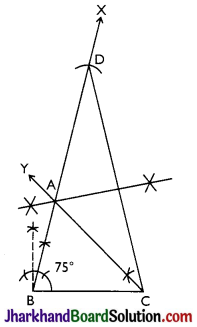
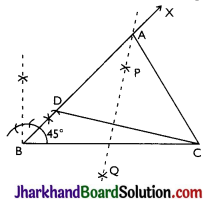
![]()

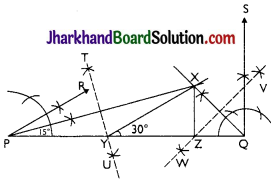
![]()


